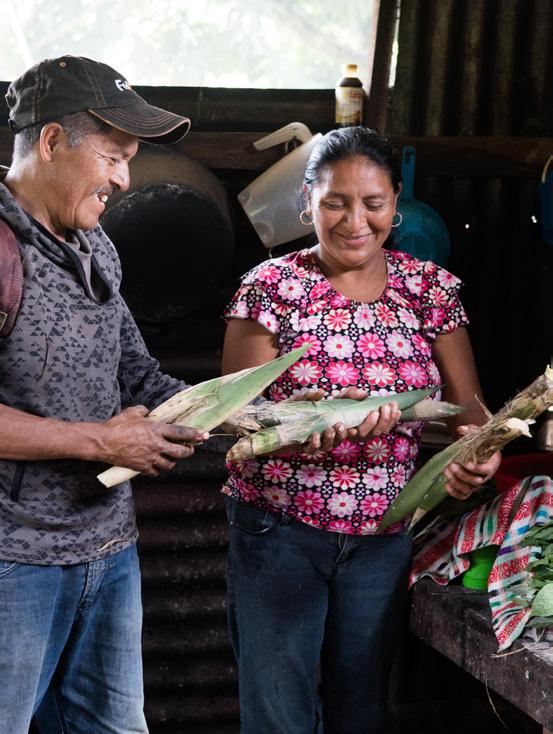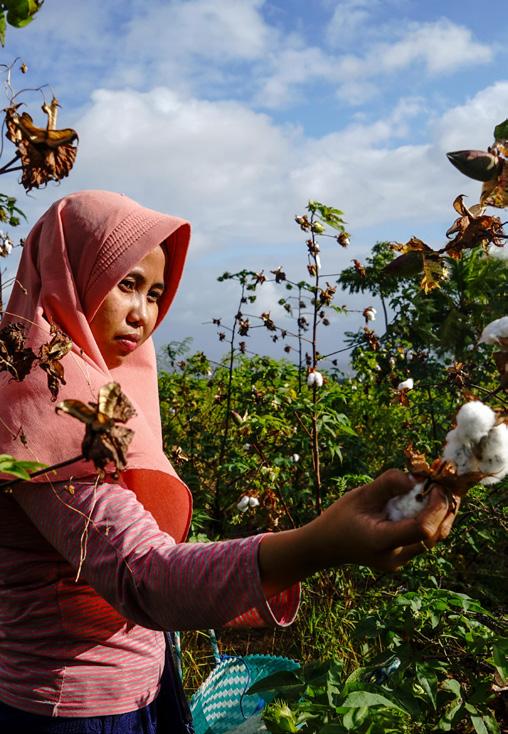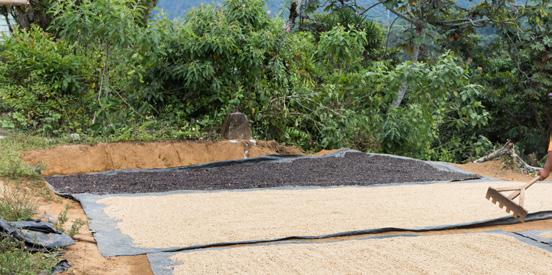

EVALUATION OF THE UNDP SUPPORT TO
EVALUATION OF THE UNDP SUPPORT TO PRIVATE SECTOR DEVELOPMENT AND STRUCTURAL TRANSFORMATION
Copyright © IEO/UNDP April 2024
The analysis and recommendations of this report do not necessarily reflect the views of the United Nations Development Programme, its Executive Board or the United Nations Member States. This is an independent publication by the UNDP Independent Evaluation Office.

PRIVATE SECTOR DEVELOPMENT AND STRUCTURAL TRANSFORMATION
T o
ev ALUATI o N o F TH e UNDP SUPP or T
ACKNOWLEDGMENTS
The Independent Evaluation Office (IEO) of the United Nations Development Programme (UNDP) would like to thank all those who have contributed to this evaluation.

EVALUATION OF UNDP SUPPORT TO PRIVATE SECTOR
ACKNOWLEDGMENTS

IEO Team
Directorate: Isabelle Mercier (Director) and Alan Fox (Deputy Director)
Corporate and Thematic Evaluations Section Chief: Vijayalakshmi Vadivelu
Lead Evaluator: Anna Guerraggio
Research and Evaluation support: Enika Bushi, Felipe Gonzalez Santos, and Shreya Rajpuriya
Stakeholders and partners
Evaluation consultants: Ghada Armali, Alexandre Daoust, Qing Gong Yang, Hugo Navajas, Andre Nsabimana, William Smith
Publishing and outreach: Flora Jimenez, Iben Hjorth
Administrative support: IEO Operations Team
UNDP staff: The evaluation could not have been completed without the support of the many UNDP staff at country, regional and headquarters offices who provided valuable insights, information and support to the evaluation.
Other stakeholders and partners: The IEO would like to also thank the government partners, representatives of the United Nations agencies, civil society, private companies and bilateral and multilateral development partners who contributed to the evaluation.
DEVELOPMENT AND STRUCTURAL TRANSFORMATION


EVALUATION OF UNDP SUPPORT TO PRIVATE SECTOR
FOREWORD

In today’s global dynamic landscape, the private sector is a vital engine of employment and economic opportunities.
In today’s global dynamic landscape, the private sector is a vital engine of employment and economic opportunities. For organizations like UNDP, fostering private sector development is not just a strategy, but a moral imperative – an avenue to reduce poverty and inequality, while nurturing sustainable prosperity for all.
Enabling equal access to markets alone will not be sufficient to achieve the ambitious targets set forth in the Sustainable Development Goals. True transformation demands a multifaceted approach, integrating progressive industrial policies, fostering dialogue with and among companies, and incentivizing sustainable business practices. It necessitates investments in enterprises that show commitment not only to profit, but also to people and the planet.
With its continued focus on private sector development and expanded ambitions to engage the private sector for structural transformation, UNDP’s work has maintained its relevance. UNDP initiatives introduced innovative thinking, mostly originating outside of projects, and enlarged the class of private sector actors with which the organization engaged. These included multinational corporations in the food and agriculture sector, financial institutions, as well as start-ups with a desire – but not necessarily the knowledge and tools – to make a positive contribution to sustainable development through their business.
UNDP achieved important results in terms of capacity development of individuals and national public institutions, and this enhanced the growth and resilience of micro-, small, and medium enterprises. While direct interventions
proved effective overall, their impact was still limited by the absence of robust theories of change that would critically articulate what stood between an enterprise and its success, and how UNDP could best meet companies’ most pressing needs. Stronger partnerships and collaborations – with different parts of the government, United Nations agencies and International Financial Institutions, as well as with private sector providers –would also be essential to realize the systemic outcomes that UNDP seeks to catalyse.
As we embark on this journey of introspection and growth, I am confident that the insights from this evaluation, along with its six actionable recommendations, will guide UNDP towards greater coherence, effectiveness and sustainability in its private sector endeavours. Let us remain steadfast in our dedication to fostering inclusive growth, forging impactful partnerships and driving systemic change that leaves no one behind.
 Isabelle Mercier Director, Independent Evaluation Office UNDP
Isabelle Mercier Director, Independent Evaluation Office UNDP
DEVELOPMENT AND STRUCTURAL TRANSFORMATION

EVALUATION OF UNDP SUPPORT TO PRIVATE SECTOR CONTENTS ACKNOWLEDGMENTS I FOREWORD IV CONTENTS V ACRONYMS + ABBREVIATIONS 1 EXECUTIVE SUMMARY 3 GLOBAL CONTEXT 5 UNDP’S WORK 6 KEY FINDINGS + CONCLUSIONS 7 RECOMMENDATIONS 11 INTRODUCTION 13 BACKGROUND 13 EVALUATION OBJECTIVES + SCOPE 15 EVALUATION QUESTIONS + METHODOLOGY 16 EVALUATION CHALLENGES + LIMITATIONS 18 GLOBAL CONTEXT 19 PRIVATE SECTOR + ECONOMIC DEVELOPMENT 21 PRIVATE SECTOR STRUCTURAL TRANSFORMATION 23

DEVELOPMENT AND STRUCTURAL TRANSFORMATION UNDP’S WORK 27 STRATEGIC APPROACH 27 PROJECTS + OTHER INITIATIVES 31 FINDINGS 35 RELEVANCE + STRATEGIC POSITIONING 37 PROGRAMMATIC APPROACH + COHERENCE 43 EFFECTIVENESS 45 ACCESS TO FINANCE + OPERATIONAL ENABLERS 65 CONCLUSIONS + RECOMMENDATIONS 71 CONCLUSIONS 73 RECOMMENDATIONS 79 GOOD PRACTICES + LESSONS LEARNED 81 MANAGEMENT RESPONSE 85 KEY RECOMMENDATIONS + THE MANAGEMENT RESPONSE 87 ANNEXES 93
ACRONYMS + ABBREVIATIONS


EVALUATION OF UNDP SUPPORT TO PRIVATE SECTOR

AfCFTA African Continental Free Trade Agreement ITC International Trade Centre
BCtA Business Call to Action IVA Impact Ventures Accelerator
CPD Country Programme Document LDCs Least Developed Countries
FACS Food and Agriculture Commodities Systems MFIs Microfinance Institutions
FAO Food and Agriculture Organization MSMEs Micro, Small and Medium Enterprises
FRRs Financial Regulations and Rules SDG Sustainable Development Goals
GDP Gross Domestic Product SFH UNDP Sustainable Finance Hub
GSIV Growth Stage Impact Venture UN Women The United Nations Entity for Gender Equality and the Empowerment of Women
ICPEs Independent Country Programme Evaluations UNCDF United Nations Capital Development Fund
IEO Independent Evaluation Office UNCTAD United Nations Conference on Trade and Development
IFIs International Financial Institutions UNDP United Nations Development Programme
INFF Integrated National Financing Framework
STRUCTURAL TRANSFORMATION
DEVELOPMENT AND
ABBREVIATIONS
EXECUTIVE SUMMARY

This evaluation of the United Nations Development Programme (UNDP) support to private sector development and structural transformation is the first dedicated global assessment by the Independent Evaluation Office of this highly strategic area of work for UNDP.
The evaluation maintained a two-fold accountability and learning goal. By examining the relevance, coherence, effectiveness and sustainability of UNDP’s work, the evaluation aimed to determine the extent to which UNDP contributed to the development of the private sector, allowing enterprises to have their most critical needs met, while promoting the structural transformation of business models towards higher sustainability, inclusion and modernization of practices. The evaluation covered the period 2016-2022.


GLOBAL CONTEXT
Enhancing private sector capacities is key for growth and poverty reduction worldwide.
Enhancing private sector capacities is key for growth and poverty reduction worldwide. Private enterprises, and particularly Micro- and Small Medium Enterprises (MSMEs), are the main source of employment and the backbone of national economies, contributing to up to 40 percent of national Gross Domestic Product.
In recent years, many developing countries experienced a surge in private sector investments, propelled by government reforms to improve the business environment, attract foreign capital and promote entrepreneurship. However, persistent policy and capacity challenges, coupled with political instability, corruption, unfavourable trade conditions and limited access to finance, continued to hamper the growth and resilience of businesses. The entrepreneurial landscape of developing countries continues to be marked by a prevalence of selfemployed individuals and microenterprises, many of which operate within the informal sector and remain highly vulnerable to external shocks.
Since 2015, the number of businesses that chose to operate sustainably grew globally, driven by increased awareness, regulatory incentives and technological advancements. Companies began responding to public demands for greater transparency and accountability by measuring and reporting their social and environmental impact. Despite a surge in sustainability pledges, unsustainable production and consumption patterns continued to exacerbate climate change and biodiversity loss. The perception of diminishing returns for shareholders and societal norms also continued to negatively influence sustainable investment decisions.

EVALUATION OF UNDP SUPPORT TO PRIVATE SECTOR e xe CUTI ve S UMMA ry |

UNDP’S WORK
UNDP’s support to private sector development and structural transformation included interventions at macro-, meso-, and downstream levels. UNDP aimed to create a more enabling environment to ease the sustainable growth of enterprises through policy advice, dialogue and capacity building of national institutions and service providers, including on supply and value chain matters and for enhanced access to finance. UNDP also provided direct support to (mostly) MSMEs by enhancing their technical and managerial capacities and promoting greener and more inclusive practices.
UNDP’s support to private sector development and structural transformation fell under the responsibility of multiple UNDP headquarters units, with corresponding functions mirrored at regional and country levels, depending on resource availability. The Istanbul International Center for Private Sector in Development, established in 2011, coordinated the development of private sector strategies and was responsible for the refinement of policies, procedures and instruments to engage programmatically with the private sector.
In the period 2016-2023, the UNDP portfolio comprised 801 projects which covered, in full or in part, activities aimed at promoting private sector development and structural transformation. The total budget was US$3.4 billion (annual average of US$420 million). UNDP and its partners primarily allocated resources in low-income countries.
DEVELOPMENT AND STRUCTURAL TRANSFORMATION
© PNUD Guatemala Caroline Trutmann
KEY FINDINGS + CONCLUSIONS

UNDP support for private sector development was designed to help small businesses, focusing on countries where needs were highest. UNDP support to private sector development primarily benefitted micro- and small entrepreneurs, in sectors where they were already employed and/or did not require large capacity development investments to start a new activity.
UNDP made deliberate efforts to include groups most at risk of being left behind, simultaneously addressing social development objectives. UNDP support to the digitalization of MSMEs and the creation of e-commerce platforms valuably helped struggling businesses during the COVID-19 pandemic.
UNDP adapted its strategic approach to promote a broader engagement of the private sector for the achievement of the SDGs. UNDP’s vision was underpinned by a stronger organizational positioning to steer private finance towards sustainable investments. Following the adoption of the Agenda 2030, UNDP Strategic Plans embodied a clearer commitment to promote the structural transformation of the private sector for greener, digital and more inclusive practices, which was then reflected in country strategies. Recognizing that the desired change would require larger private investments in productive economic activities in line with the SDGs, UNDP strengthened its internal capacities to fill a gap left by International Financial Institutions and other organizations traditionally engaged in promoting access to finance around the definition of strategies and instruments to enhance SDG-aligned investments.

UNDP strategies on private sector development and partnership were not translated into programmatic approaches that effectively utilized UNDP’s multiple offers. UNDP did not have one specific niche that made it the most suitable partner to governments for private sector development and structural transformation. The value added of the organization lay in the breadth of its mandate and experience, which gave UNDP an opportunity to use multiple entry points to promote change. Numerous UNDP offers were rarely brought together at country level in more coherent programmes that addressed the most important needs of the private sector. UNDP support to MSMEs remained disjointed from other initiatives that aimed to bring the private sector in closer alignment with the SDGs.
The focus of UNDP projects was skewed towards direct assistance to micro- and small enterprises, with insufficient appreciation of meso-level interventions. The provision of direct support to entrepreneurs was relevant but did not always respond to the most pressing needs faced by companies. Primary and secondary data sources consulted by the evaluation team questioned the assumption, on which numerous UNDP projects had been planned, that self-employment was the most effective way out of poverty and training the best way to spur growth . UNDP downstream-level work rarely occurred through the lens of a ‘private sector development approach,’ with inadequate attention paid to market requirements, barriers to trade and supply-demand balances. UNDP
EVALUATION OF UNDP SUPPORT TO PRIVATE SECTOR
rarely adopted sectoral approaches, which could have facilitated more integrated interventions. Examples of collaboration among UNDP, more specialized United Nations agencies, and International Financial Institutions were limited, reducing the opportunities to achieve higher effectiveness.
The evidence regarding UNDP’s effectiveness on the improved productivity, resource efficiency and income of project beneficiaries was generally positive, but inconclusive. The knowledge and assets provided by UNDP generally helped to increase motivation, productivity and income for individuals who were struggling to maintain their business and were at risk of being left out. Most respondents to the IEO survey considered UNDP programmes impactful in terms of reputational effects and economic gains, while less helpful in providing access to new markets and/or promoting more participation of women in the workforce at all levels.
UNDP’s more impactful efforts on trade and value chains, while limited in scope, were realized through regionally coordinated projects and work around ‘anchor companies.’ Significant achievements were realized when UNDP adopted an integrated approach covering macro-, meso-, and downstream levels, and when it collaborated with other institutions. Support to the elaboration and/or amendment of strategies, laws and regulations enhanced capacities of national stakeholders and trade support institutions, with trickle down effects for companies in terms of trade opportunities, productivity and income gains. In other contexts, work around select value chains promoted better relationships among companies and a deeper understanding of buyers’ and sellers’ requirements and needs. Larger companies became involved in the professionalization of their suppliers, with reported growth in sales and customers.
UNDP’s prolonged support to national institutions had important effects, leading to enhanced capacities and institutionalization of services to (micro)-entrepreneurs, particularly in Middle Income Countries. With UNDP’s support, public institutions delivered business development services to existing and aspiring entrepreneurs, mostly through information sharing, training and to a lesser extent advice on registration procedures, product improvement and commercialization. With few exceptions, the effects of the offered services were often unknown, as important gaps remained in the institutions’ monitoring and evaluation systems, particularly in cases where UNDP’s support had diminished over time. The continuity of UNDP’s
support and technical advice was important to enhance the sustainability of institutions by also crowding in contributions by other international partners.
UNDP direct support to institutional capacity development at times came at the expense of a more organic vision of business needs, with limited attempts to promote public institutions as business service integrators. Opportunities to leverage UNDP’s convening role for promoting inter-institutional linkages and facilitating the integration of business associations and private providers of services remained unexplored. As public institutions dealt with ongoing challenges related to resources and efficiency, there was insufficient focus on establishing business support ecosystems involving private sector providers. The engagement of Chambers of Commerce was not frequent, but proved to be valuable, including from a sustainability perspective.
UNDP promoted closer alignment of business practices to the SDGs. Through its acceleration programmes, UNDP enhanced the capacities of mostly young and emerging entrepreneurs who wanted their companies to grow and contribute to sustainable development, creating opportunities to redefine the visions of those businesses, create new products and foster some connections with funders. The alignment of companies’ goals to the SDGs was challenged, however, by the novelty of the topic and the limited availability of incentives, reinforcing the intention-action gap. Identifying specific business solutions proved easier than attempting to align the core of the business to the SDGs.
UNDP played an important role in championing environmental policy changes and promoting sustainable business practices, resulting in reported positive impacts on the environment and a decrease in ozone-related harm. The establishment of dialogue mechanisms for the sustainable production of major food items provided producers with opportunities to voice their requests and concerns, but often stopped after the projects ended. UNDP’s experience across countries demonstrated that farmers and entrepreneurs continued struggling with better pricing for sustainable products (particularly in local markets) and vertical scaling, in the absence of external funding or investment opportunities. The most successful projects were built on companies and networks with established sustainability and certification schemes.
DEVELOPMENT AND STRUCTURAL TRANSFORMATION e xe CUTI ve S UMMA ry | 8
UNDP’s approach to supporting the private sector in reducing inequality was not clearly defined and received less attention than necessary. The integration of a Leave No One Behind approach in UNDP programming resulted in the organization paying systematic attention to the inclusion of marginalized groups in business activities. UNDP interventions produced some economic gains but their reach and the number of people who benefitted were limited. UNDP often struggled to promote more transformative changes, given the width of capacity asymmetries, social norms and power dynamics at play. The largest dedicated programmes in this area were discontinued. UNDP’s Gender Equality Seal for Private Sector process strengthened companies’ internal policies, mitigating the risk of open discrimination against women, but struggled with scaling. Even so, over time, UNDP positioned itself as a strong interlocutor in the area of Business and Human Rights. The dialogue facilitated by UNDP enhanced trust among stakeholders and started influencing change among companies, particularly in countries with a more enabling political environment.
Until recently, access to finance was not a central aspect of UNDP’s programming. While acknowledged as a critical constraining factor to the growth and sustainability of businesses, enabling access to finance was not at the forefront of UNDP’s work to support private sector development and structural transformation. Because of its mandate, UNDP offered limited direct financial assistance to MSMEs. Most support came in the form of small grants competitively distributed, the administration of which presented efficiency challenges for both UNDP and the applicants. UNDP lacked an appropriate financial mechanism to effectively channel resources and support initiatives co-financed by investors and external partners. Collaborations with banks and intermediary organizations in Middle Income Countries succeeded in raising capital. UNDP’s intensified emphasis on SDGs finance enabled the planning of regulatory reforms to support private sector alignment with the SDGs. Investor Maps fostered informed dialogues among relevant stakeholders and partners, but tangible financial opportunities are yet to manifest.
The change in UNDP’s vision and strategies on private sector engagement did not translate into a corresponding shift in the organization’s culture and policy framework. UNDP has long acknowledged the need to adapt its internal private sector engagement instruments, deemed inefficient and unsuited to respond to requests for collaboration and promote equal partnerships with the private sector. Evidence collected by the evaluation team validated the urgent need for a policy and practice review to address recurring issues around efficiency of contracting processes, co-investments, enabling access to finance and risk appetite. UNDP’s most recent approach to advance private sector partnerships, defined as one of the 12 strategic priority areas for the first 100 days of the Strategic Plan 2022-2025, was well aligned with the challenges identified by the evaluation but required accelerating action to resolve contentious issues.


EVALUATION OF UNDP SUPPORT TO PRIVATE SECTOR


DEVELOPMENT AND STRUCTURAL TRANSFORMATION
© PNUD Guatemala Caroline Trutmann
RECOMMENDATIONS
01
02
03


UNDP should define how its multiple service offers could be better leveraged to promote more integrated and coherent support for private sector development and structural transformation. UNDP should develop a full theory of change for its Private Sector Development and Partnership strategy to identify how the application of UNDP service offers helps the private sector address its needs to grow, become resilient and transform its practices towards higher sustainability. The exercise, which should be repeated at regional and/or country level and run in consultation with private sector stakeholders, should help UNDP prioritize a dedicated set of interventions that best respond to companies’ needs, while favouring the integration of different tools for more effective support.
Across its projects, and including those focused on livelihoods support, UNDP should enhance the integration of market-based approaches and the promotion of supply and value chains, particularly in middle-income countries. The design of all UNDP projects aimed at promoting the development or structural transformation of the private sector, including micro- and small entrepreneurs, should question the marketability of supported products or services. When challenges are identified, UNDP should avoid a default response of setting up a new institution, programme or initiative to address the issue. UNDP should rely to the extent possible on existing national institutions, strengthening their capacities for higher sustainability, and enhance its collaboration with Chambers of Commerce and business associations as enablers of private sector growth. On trade, UNDP should enhance its partnerships with the United Nations Conference on Trade and Development (UNCTAD) and International Trade Centre (ITC), to ensure the full integration of their tools and capacities, which UNDP country presence will help further disseminate. UNDP should enhance its support to e-commerce through more comprehensive interventions.
UNDP Country Offices should strengthen their support to private sector development and structural transformation by focusing on sectors that can significantly contribute to poverty reduction and a greener economy. UNDP should build its programmes on existing market analysis, including SDG Investor Maps, and/or explore foresight tools to identify future areas of possible engagement, including for the promotion of circular economies. Sectoral approaches should comprehensively assess the existing barriers to growth and structural transformation, including regulations and policy incentives, and work with partners on multiple entry points for higher-impact interventions.
EVALUATION OF UNDP SUPPORT TO PRIVATE SECTOR

04

UNDP should strengthen its engagement with larger companies and network of private sector enterprises, both at global and regional/country levels, to promote the integration of MSMEs in global value chain on fair terms and private sector’s structural transformation at broader scale. UNDP should facilitate dialogue between companies of different sizes, and possibly create Business Advisory Councils on key thematic and/or geographic areas of engagement. Through these dialogues, UNDP could develop offers that better respond to market incentives and/or align with existing sustainability initiatives by companies. Lessons learned from UNDP experience with Food and Agriculture Commodities Systems (FACS) dialogue mechanisms, the SDG Impact steering group, and with the advisory group established for the Regional Bureau for Africa should inform the terms of these platforms. UNDP should clarify its positioning and support to promote a stronger role by the private sector in reducing inequality. The knowledge gained through the Business Call to Action’s (BCtA’s) implementation should be integrated into future initiatives and projects for the continued promotion of inclusive business practices.
05
06
UNDP should comprehensively identify and consider all the factors affecting the decisions of investors to support private companies in developing countries and focus on those that are more in line with its capacities and comparative advantages UNDP should focus on policy de-risking and enhance private sector productive and managerial capacity to attract national and foreign investments, including through the development of bankable business plans and pipeline of investment-ready projects. UNDP should continue facilitating the engagement of national and international financial institutions and intermediary services to promote a stronger alignment of finance flows for the development of private sector opportunities for the SDGs.
UNDP should finalize the changes to its policies and regulations, based on the recommendations by its internal private sector task force. UNDP should develop instruments that facilitate engagement with the private sector as a partner, including for jointly designed initiatives. If considered appropriate and approved by the Administrator, UNDP should present proposals for changing the Financial Regulations and Rules (FRRs) to the Executive Board for its deliberation, following established processes. The implementation of the revised due diligence policy should be monitored at regular intervals to ensure that capacity issues and other aspects do not hamper prompt decision-making. Risk assessment should be digitized and use of external resources enabled to quicken the cross-check of information. UNDP should provide clear guidance to its staff on the application of rules by type of engagement and ensure adequate dissemination to promote a risk-responsive organizational culture, which gives greater recognition to the development role of the private sector.
DEVELOPMENT AND STRUCTURAL TRANSFORMATION
INTRODUCTION BACKGROUND
The evaluation of the United Nations Development Programme (UNDP)’s support to private sector development and structural transformation is the first dedicated global assessment by the Independent Evaluation Office (IEO) of this highly strategic area of work for UNDP. The evaluation was conducted as part of the revised IEO multi-year programme of work 2022-2025,1 and was to be presented to the Annual Session of the UNDP Executive Board in June 2024.
The evaluation aims to provide insights on results achieved and lessons learned from UNDP’s past support to private sector development and structural transformation. These are expected to inform the implementation of the UNDP Private Sector Development and Partnership Strategy 20232025, ‘Making markets work for the SDGs,’ and contribute to the global discussion on the role of the private sector in promoting sustainable development.
Box 1: UNDP’s definition of private sector
The private sector is a basic organizing principle of economic activity in a market-based economy where private ownership is an important factor, markets and competition drive production, and private initiative and risk-taking set activities in motion. The private sector includes a wide range of market actors that may operate either in the informal or formal economy, and which UNDP may work with, [such as]: for-profit and commercial enterprises of any size; corporate foundations; business associations, coalitions, and alliances; and State-owned enterprises.
Source: UNDP Private Sector Development and Partnership Strategy (2023-2025).

1 The IEO communicated the revision to the workplan through its Annual Report on Evaluation 2022, presented to the Executive Board in June 2023 (DP/2023/16).
CHAPT er 1


INTRODUCTION
EVALUATION OBJECTIVES + SCOPE2
The evaluation aimed to determine the extent to which UNDP had contributed to the development of the private sector, while promoting the structural transformation of business models towards higher sustainability, inclusion and modernization of practices.
The evaluation of UNDP’s support to private sector development and structural transformation maintained a two-fold accountability and learning goal. By examining the relevance, coherence, effectiveness and sustainability of UNDP’s work, the evaluation aimed to determine the extent to which UNDP had contributed to the development of the private sector, allowing enterprises to have their most critical needs met, while promoting the structural transformation of business models towards higher sustainability, inclusion and modernization of practices. In line with UNDP’s Private Sector Development and Partnership Strategies (2018 onwards), the evaluation covered UNDP’s support at the macro- (policies, incentives and dialogues), meso- (institutional development, value chain, market and finance) and downstream (productivity and business practices) levels. The evaluation did not specifically examine UNDP’s financial partnerships with the private sector or its engagement with companies in pursuing the Sustainable Development Goals (SDGs) unless it was part of a deliberate effort to develop or transform businesses. 3
Box 2: Definitions used in the evaluation4
Private sector development: support to private enterprises to enhance their growth, competitiveness and resilience
Private sector structural transformation: change processes for green, inclusive and digital transitions of enterprises
Private sector engagement: collaborations with the private sector to advance the sustainable development agenda at large or in specific sectors (e.g., health)
The evaluation covered the period 2016-2022, encompassing three UNDP Strategic Plan cycles, one of which was approved before the definition of the SDGs. The evaluation also looked at programme activities up to September 2023 when they reflected changes in UNDP’s strategic direction or when there were examples of results stemming from previous efforts
2 For more details, please consult the evaluation’s terms of reference (Annex 1).
3 The evaluation did not cover in detail UNDP’s support to private sector development in the area of energy or for youth economic empowerment, which were the subjects of IEO evaluations in 2021. The evaluation did not assess UNDP’s work in the area of extractive industries.
4 Sources: UNDP. (2016). Policy on Private Sector Partnerships; UNDP. (2018) Strategic Plan 2018-2021.
EVALUATION OF UNDP SUPPORT TO PRIVATE SECTOR INT ro DUCTI o N | 15
EVALUATION QUESTIONS + METHODOLOGY
The evaluation assessed UNDP’s support to private sector development and structural transformation according to international standard evaluation criteria.5

FIGU re 1
EVALUATION QUESTIONS6
Evaluation criterion Question
Relevance To what extent has UNDP contributed to addressing the most critical development needs of the private sector at national level, with a focus on priority industries for economic and sustainable growth?
(Internal) Coherence To what extent has UNDP’s support to private sector development integrated sustainability considerations to green processes, reduce inefficiencies and limit the impact of growth on the environment?
(External) Coherence To what extent has UNDP created, and relied on, synergies with other interventions by governments, United Nations agencies, International Financial Institutions (IFIs), and other development partners?
Effectiveness
• To what extent has UNDP’s support at policy and regulatory level enabled the development of the private sector, easing the way of doing business and promoting economic diversification?
• To what extent has UNDP enhanced the ecosystem for private sector development and contributed to strengthening sustainable value chains?
• To what extent has UNDP enhanced the productivity of the private sector, improving income and livelihoods of those engaged in it?
• What benefit has UNDP’s support to the structural transformation of the private sector brought? 7
Sustainability To what extent has UNDP contributed to unlocking institutional capacities and mechanisms that are likely to be sustained in the medium-long term?
5 OECD DAC Network on Development Evaluation. (2019). Better criteria for better evaluation. OECD.
6 The Evaluation Matrix (Annex 2) includes an expanded version of the evaluation questions.
7 This would include support to digitalization, greener practices, gender equality and inclusion.
DEVELOPMENT AND STRUCTURAL TRANSFORMATION
The evaluation employed mixed methods to answer its questions and test some of the hypotheses formulated in the reconstructed theory of change. The evaluation approach was largely influenced by Outcome Mapping, Most Significant Change, and Contribution Analysis approaches. The evaluation also piloted the integration of combined behavioural science frameworks, most notably the COM-B model, to determine UNDP’s ability to leverage different pathways for change. 8 Given the breadth and diversity of UNDP’s support in this area, at the outset of the evaluation the IEO mapped
FIGU re 2
EVALUATION METHODOLOGY
Document review
• Review of UNDP strategic and programmatic documents
• Content analysis of a balanced sample of 58 UNDP Country Programme Documents (CPDs)
• Literature review of economic papers, research on private sector development’s drivers, studies on green transformation of businesses9
Case studies
• 8 country-level studies, selected based on: size of 2016-2023 identified portfolio, countries’ income and geographic balance, and absence of (or limited) evaluation coverage11
• Coordination with 3 ICPEs conducted in 2023 12
• Desk-based study of UNDP’s support to Food and Agriculture Commodities Systems (FACS)
• Desk-based study of newer/more innovative approaches to promote access to finance
relevant UNDP interventions and engaged in extensive consultations with UNDP colleagues to define through a ‘snowball effect’ a purposive sample of initiatives to be analysed in more detail (see Annex 3). An iterative and adaptive data collection process allowed the direction of the evaluation to be adjusted based on emerging evidence, while remaining within the framework set in the Terms of Reference. Unless otherwise specified, evaluation findings were based on the triangulation of different data sources.
Correlation analysis
• Statistical analysis of the relationship between UNDP’s programming size10 and contextual variables, including countries’ income and employment levels, competitive industrial performance, and status of entrepreneurial ecosystem development
Interviews
Interviews of more than 500 individuals at headquarters, regional and country levels; These comprised:
• 277 UNDP staff
• 105 private sector representatives
• 59 representatives of National Governments
• 36 United Nations partners
• 23 members of civil society
8 More details on the evaluation methodology are available in Annex 1.
9 A list of documents and sources consulted is available in Annex 5.
10 Obtained through the IEO Data Mart on Power Bi.
11 Bosnia and Herzegovina, Burkina Faso, Colombia, Dominican Republic, Egypt, Ethiopia, Nepal and South Sudan.
12 Paraguay, Rwanda and Yemen.
Meta-analysis
• 13 IEO thematic evaluations
• 44 Independent Country Programme Evaluations (ICPEs)
• Relevant decentralized evaluations, identified through the IEO Artificial Intelligence for Development Analytics (AIDA)
Questionnaire
Survey of companies and entrepreneurs that participated in four UNDP global initiatives:
• SDG Value Chain programme
• Business Call to Action
• Impact Venture Accelerators
• BOOST
The survey received 447 responses (33.5 percent of targeted individuals).
EVALUATION OF UNDP SUPPORT TO PRIVATE SECTOR INT ro DUCTI o N | 17

Through its various tools, the evaluation analysed the extent to which UNDP’s support to the private sector had contributed to enhanced gender equality. This included a review of gender marker data and the integration of the IEO gender-results effectiveness scale in its analysis. The IEO developed protocols to promote consistency in data collection against the evaluation questions and to ensure the full respect of ethical considerations, particularly around anonymity, data protection and informed consent, in line with the Ethical Guidelines for Evaluation set by the United Nations Evaluation Group (2020).
EVALUATION CHALLENGES + LIMITATIONS
Evaluating UNDP’s support to private sector development and structural transformation was a challenging endeavour, given the size and breadth of UNDP’s work in this area. UNDP’s private sector development and partnership strategies served as a valuable anchor to map the most relevant global initiatives to cover, supplemented by IEO’s independent research and close engagement with UNDP colleagues. While the IEO took care to identify UNDP’s support across areas of work, some streams might have escaped the attention of the evaluators or been covered in less detail.
The evaluation was challenged by the small number, quality and availability of monitoring data available at project level. While the IEO could count on the collaboration of UNDP country offices to gather information, the exercise was extremely resource-intensive, and information gaps (particularly at outcome level) remained. To overcome this challenge, the evaluation enhanced its reliance on primary data collection through dedicated outreach efforts and open sources.
DEVELOPMENT AND STRUCTURAL TRANSFORMATION INT ro DUCTI o N | 18
© UNDP Jamaica Talk Up Yout Media
GLOBAL CONTEXT

Mid-way to 2030, the fight to eradicate extreme poverty for all has shown limited progress. The COVID-19 pandemic and increased instability made 165 million people fall into poverty. Although the global economy began to rebound in 2021, bringing some improvement in unemployment rates, the post-pandemic recovery remains elusive and fragile, particularly in Least Developed Countries (LDCs).13 Twenty-five developing economies, the highest number since 2000, had to allocate more than 20 percent of their government revenues on total external debt servicing.14
13 United Nations. (2022 and 2023). The Sustainable Development Goals Reports – SDG 8 update. 14 Ecker, S. et al. (2023). The human cost of inaction: poverty, social protection and debt servicing, 2020-23. UNDP Development Future Series.
CHAPT er 2


PRIVATE SECTOR + ECONOMIC DEVELOPMENT
Enhancing private sector capacities is key for growth and poverty reduction worldwide.
Enhancing private sector capacities is key for growth and poverty reduction worldwide. Private enterprises, particularly Micro- and Small and Medium Enterprises (MSMEs) are the backbone of national economies and the main source of employment, engaging 90 percent of national workforces and contributing to up to 40 percent of national Gross Domestic Products (GDPs).15
In recent years, many developing countries experienced a surge in private sector investments, propelled by governments’ reforms to improve the business environment, attract foreign capital and promote entrepreneurship. Persistent challenges such as inconducive industrial policies, political instability, conflict and corruption, however, continue to hamper the growth and resilience of businesses. Unfavourable conditions further hinder the potential of trade to drive development, particularly in LDCs where economic growth relies heavily on a few commodities.16 The insufficient capacity of essential services (transport and logistics, energy, information and communication technologies, and business and professional facilities) also undermine companies’ ability to participate in commercial exchanges and be connected to larger-scale value chains. Addressing these systemic weaknesses remains crucial for unlocking the full potential of the private sector and fostering sustainable development.
The entrepreneurial landscape of developing countries is marked by a prevalence of self-employed individuals and microenterprises, many of which operate within the informal sector. Despite their crucial role in providing employment and sustenance for billions of people, especially in underserved communities, these ventures remain highly vulnerable to external shocks due to lower wages and limited social protections. Higher levels of risks of closure and unemployment disproportionately affect women and youth, who find it more difficult to access bank financing to grow.17
It is estimated that 40 percent of MSMEs in developing countries – approximately 65 million firms – have unmet financing needs, totalling US$5.2 trillion, equivalent to 1.4 times the current level of the global MSME lending.18 Financial institutions consider MSMEs as too high-risk and high-cost to acquire, underwrite and serve as clients.19 The request for audited financial statements, tax returns and collaterals remains a high entry barrier for many companies seeking loans. 20 Equity finance continues to be a limited option for MSMEs, partly linked to the companies’ preference to retain control of their business and due to legal constraints posed to foreign investors.
15 Source: World Bank and International Finance Corporation.
16 International Trade Center. (2022). SME Competitiveness Outlook: connected services, competitive businesses.
17 Hammond, A et. al. (2007) The Next 4 Billion Market Size and Business Strategy at the Base of the Pyramid. World Resources Institute and International Finance Corporation.; Elgin, C., Klose, M. A., Ohnsorge, F, & Yu, S. 2021. Understanding Informality. CERP Discussion Paper 16497, Centre for Economic Policy Research, London.
18 https://www.worldbank.org/en/topic/smefinance
19 Fišera, B., et al. 2019. Basel III Implementation and SME Financing: Evidence for Emerging Markets and Developing Economies. World Bank Policy Research Working Paper 9069.
20 International Finance Corporation. (2017). Alternative data transforming SME finance.
EVALUATION OF UNDP SUPPORT TO PRIVATE SECTOR GL ob AL C o NT ex T | 21

FIGU re 3
LOWER INCOME COUNTRIES HAVE LESS PRODUCTIVE CAPACITIES AND RELY MORE ON THE INFORMAL SECTOR TO SUPPORT LIVELIHOODS.
Source: United Nations Conference on Trade and Development, Productive Capacities Index (2022) and International Labour Organization Labour Force Surveys (latest available data).
DEVELOPMENT AND STRUCTURAL TRANSFORMATION
PRIVATE SECTOR STRUCTURAL TRANSFORMATION
The 2030 agenda for Sustainable Development recognizes the private sector not only as a beneficiary of assistance in developing and emerging economies, but also as an enabler and promoter of inclusive sustainable practices, and a contributor of resources, innovation and knowledge.
The 2030 agenda for Sustainable Development recognizes the private sector not only as a beneficiary of assistance in developing and emerging economies, but also as an enabler and promoter of inclusive sustainable practices, and a contributor of resources, innovation and knowledge. 21 Building on the international community’s commitment to the Sustainable Development Goals (SDGs), as also echoed in the Addis Ababa Action Agenda and the Paris Agreement on Climate Change, 22 the United Nations has urged a different development pathway that fully engages the private sector as a
partner with shared responsibility. More governments are recognizing the need for industrial strategies that not only catalyse, but also direct, growth towards greener, more inclusive and more resilient economies. 23 The private sector’s commitment towards a ‘net-zero, nature positive, and more equitable future’ 24 has manifested in a higher number of sustainability pledges, 25 while risks of ‘green washing’ remain widespread. 26
21 United Nations. (2015). Transforming our world: the 2030 Agenda for Sustainable Development (A/RES/70/1).
22 United Nations. (2015). Addis Ababa Action Agenda of the Third International Conference on Financing for Development; United Nations. (2015). Paris Agreement.
23 Mazzucato, M. & Rodrik, D. (2023). Industrial Policy with Conditionalities: A Taxonomy and Sample Cases. Working paper WP 2023/07. Institute for Innovation and Public Purpose, University of the City of London.
24 World Business Council for Sustainable Development. (2021). Vision 2050: Time to transform.
25 The share of companies publishing sustainability reports, as monitored by the United Nations, has increased threefold in the period 2016-2021. See also Hestad, D. (2021). The evolution of Private Sector Action in Sustainable Development. IISD Earth Negotiation Bulletin.
26 United Nations. (2023). The Sustainable Development Goals report – special edition.
EVALUATION OF UNDP SUPPORT TO PRIVATE SECTOR GL ob AL C o NT ex T | 23
BUSINESSES + THE ENVIRONMENT
Since 2015, there has been a notable growth in sustainable and greener businesses worldwide, including in developing countries. Growing concerns about climate change, pollution and environmental degradation increased awareness among consumers, businesses and policymakers about the importance of sustainability, leading to a greater demand for eco-friendly products and services. Regulatory incentives and advances in technology played a pivotal role in making sustainable practices more affordable and accessible. However, many companies, especially those in developing countries, still encounter obstacles in adopting greener practices. Policy barriers, capacity constraints, and limited access to financing remain significant challenges. For small businesses, which report higher climate-related environmental risks to their operations, available material incentives are often insufficient to offset the immediate costs of the required technology and production changes and convince entrepreneurs to adopt new practices.
Unsustainable patterns of production and consumption continue to exert immense pressure on fragile ecosystems, serving as the primary driver of triple planetary crises of climate change, pollution and biodiversity loss. 27 Since the 1990s, the global material footprint has surged, surpassing both population growth and economic demands (see figure 4). In 2021-2022, emissions from industrial processes soared to unprecedented levels, paralleled by a substantial increase in fossil fuel subsidies, outbalancing the positive results achieved with the increased adoption of renewable energies. 28 The upward trajectory in emissions and resource consumption has primarily been driven by the practices of developed economies, which historically hold significant influence in global production and consumption networks. The persistence of inadequately enforced regulations and competing short-term economic interests further challenged the adoption of greener practices by the private sector.

re 4
MATERIAL FOOTPRINT INCREASED MORE THAN GDP AND POPULATION (2000-2017,
Source: United Nations Sustainable Development Goals report, 2019.
DEVELOPMENT AND STRUCTURAL TRANSFORMATION
27 United Nations. (2022). The Sustainable Development Goals report. 28 United Nations. (2022). The Sustainable Development Goals Report; International Monetary Fund. (2023). Fossil fuel subsidies surged to record 7 trillion.
BASELINE 2000=100)
FIGU
2000 100 180 170 160 150 140 130 120 110 2002 2000 2006 2008 2010 2012 2014 2016 Material footprint GDP Population
DIGITALIZATION
Propelled in part by the COVID-19 pandemic, companies worldwide increased the use of digital tools to support commerce and trade, with positive impact on business operations and income. 29 Enhanced availability of digital finance services also allowed MSMEs to conduct transactions more efficiently, lowering costs and offering smaller companies access to capital for investment. While a growth in business connectivity was recorded across countries and income levels, many enterprises in less developed countries did not manage to capitalize
on growing e-commerce opportunities. Connectivity and data infrastructure, skills, and the availability of financial resources fed a growing digital gap. Barriers to digital adoption more acutely impacted micro- and small companies, particularly those owned by women, which mostly continue operating offline or using a mobile phone to access suppliers and consumers. 30 In LDCs, less than 10 percent of people use the internet to shop. 31
WHILE DIGITAL ECONOMIES EXPANDED GLOBALLY, THE E-COMMERCE ACCESSIBILITY GAP BETWEEN LDCS AND DEVELOPED COUNTRIES WIDENED.
Source: United Nations Conference on Trade and Development (UNCTAD) Business to Consumer index

29 United Nations. (2023). Entrepreneurship for sustainable development. Report of the Secretary General (A/277/54).
30 Broadband Commission for Sustainable Development, ITU, & UNESCO. (2023). Making Digital Connectivity Work for MSMEs. Working group report on connectivity for SMEs.
31 United Nations Conference on Trade and Development (2021). Cross-border data flows and development: for whom the data flow. Digital economy report 2021.
EVALUATION OF UNDP SUPPORT TO PRIVATE SECTOR
FIGU re 5
2016 E-commerce gap 53 points E-commerce gap 59 points 2017 2018 2019 2020 70 83 83 83 82 53 53 52 50 43 17 22 24 24 23 LDCs Developed economies Developing economies (LDC excluded)
INCLUSIVE BUSINESSES
The 2030 agenda fully integrates the concept of ‘inclusive businesses,’ which UNDP and others have spearheaded for almost two decades. Under this framework, business leaders are encouraged to engage less affluent individuals as producers, clients and employees, promoting inclusivity as a sensible business strategy, with benefits in terms of value creation in the long-run, better risk management, higher resilience, and improved financial performance. 32
Since 2015, the landscape of inclusive businesses has rapidly evolved, driven by advances in technology, evolving investor preferences, shifting consumer expectations, and supporting policy environments. An increasing number of companies have begun to
respond to public demands for greater transparency and accountability by measuring and reporting their social and environmental impact. But the perception of diminishing returns for shareholders, and societal norms, particularly around gender and race, continue to negatively influence investment decisions in these areas. 33 In some cases, the application of new environmental regulations has also unintendedly enhanced the risk of excluding small businesses from global value chains, with unresolved trade-offs between different goals. The implementation of the Guiding Principles on Business and Human Rights, which was endorsed by the United Nations Human Rights Council in 2011, has been uneven. 34

32 UNDP. (2019). What does it take to go big? Management practices to bring inclusive business to scale.
33 UNDP. (2023). Breaking down gender biases: shifting social norms towards gender equality; Guttentag, M., et al. (2021). Does acceleration work? Five years of evidence from the Global Accelerator Learning initiative.
34 United Nations. (2021). Guiding Principles on Business and Human Right at 10. Report of the Working Group on the issue of human rights and transnational corporations and other business enterprises. (A/HRC/47/39).
DEVELOPMENT AND STRUCTURAL TRANSFORMATION
© UNDP Maldives

UNDP’S WORK
STRATEGIC APPROACH
THE UNDP STRATEGIC PLANS
UNDP Strategic Plans have consistently covered private sector development to promote job creation, economic gains and livelihood improvements for the poorest and most disadvantaged individuals, including women, youth, informal sector workers and populations affected by crises and conflict. Starting from the 2018-2021 Strategic Plan, UNDP introduced the concept of ‘structural transformation’ to stress the importance of working towards more inclusive and greener business practices, while leveraging digitalization and technological advancements to promote development. In addition to a sustained focus on women’s economic empowerment and leadership, a stronger focus on the role of the private sector in promoting human rights and addressing human mobility considerations emerged in the Strategic Plan 2022-2025.
CHAPT er 3


UNDP Strategic Plans acknowledge the importance of partnering with the private sector and stress the need to expand and improve collaboration. Dedicated indicators were introduced to measure private sector engagement across areas. UNDP Strategic Plans also highlight the central role of private investments for the achievement of the SDGs, particularly on energy and natural resource management issues. UNDP is seen as a facilitator of investment, through the development of policy de-risking strategies, financial tools and pipelines of bankable projects.
The UNDP Strategic Plan 2022-2025 addresses the internal and external factors that can hamper the partnership with the private sector. The Plan acknowledges the disruptive nature of the change it aims to create, with a shift in investment incentives. As UNDP commits to promote a fair transition that will mitigate the impact on vulnerable populations, the Plan is less explicit on how the resistance to change among more powerful actors will be addressed. The Strategic Plan also recognizes the need for more flexible instruments and modalities of engaging the private sector, particularly around intellectual property and financial matters.
UNDP STRATEGIES
UNDP has developed Private Sector Partnership Strategies (differently labelled) since 2007. In line with the Strategic Plans’ focus, the strategies covered:
1. private sector development;
2. engagement to stimulate investments; and
3. partnerships to reduce business’ environmental footprint and apply human rights standards.
The theory of change of the two latest strategies (20182022 and 2023-2025) suggests that “if businesses have access to capital that seeks economic, social, and environmental results and they can adapt their strategies and operations accordingly, and policy, legal and regulatory environments prioritize investment in sustainable development, then markets will work for the SDGs.” The strategies illustrate the importance for UNDP to:
1. move from short-term, company-led partnerships to transformative and systemic engagement;
2. implement focused initiatives with measurable performance indicators;
3. improve staff capacity; and
4. streamline tools and adjust internal operational mechanisms.
In 2023, UNDP developed a dedicated guidance to support the implementation of market-based solutions in crisis and post-crisis settings.
Box 3: UNDP’s vision on private sector development and partnership
By 2030, the SDGs will be the main global guidance framework for businesses, investors and governments, unlocking US$1 trillion in private capital and increasing the number of businesses of all sizes that align their strategies and operations with the SDGs. This will be supported and regulated by a policy environment that reduces risk and fosters an inclusive and green economy, leading to the eradication of poverty.
In its Nature Pledge, UNDP committed to shift business behaviours towards nature-positive practices that create inclusive and greener jobs, dismantling the assumption that economic development and environmental conservation are a zero-sum game. 35 UNDP also developed a Food and Agricultural Systems (FACS) Strategy (2020-2030) and a related Strategy for Private Sector Engagement (approved in 2023), which advocate for a change in current agricultural paradigms of yield maximization through dialogue, policy change, and incentives for small-scale producers. The Private Sector Strategy of the Scaling up Climate Ambition on Land Use and Agriculture through Nationally Determined Contributions and National Adaptations Plans programme (SCALA) further sets goals around the adoption of climate resilient practices by companies seeking to mitigate risks in their operations.
UNDP’s engagement with the private sector to achieve gender equality spans across signature solutions. The UNDP Gender Equality Strategy 2022-2025 set an intention to expand collaboration with the private sector to promote women’s leadership and participation, develop inclusive workplaces, and ensure equal pay for equal work. UNDP also planned to engage private firms on preventing gender-based-violence.
35 UNDP. (2023). UNDP’s commitment to support countries to deliver the Global Biodiversity Goals and achieve the 2030 Agenda.
EVALUATION OF UNDP SUPPORT TO PRIVATE SECTOR UNDP'S W or K | 29

UNDP POLICIES: DUE DILIGENCE AND FINANCIAL RULES
UNDP policies and regulations manage and mitigate reputational risks associated with private sector partnerships, ensuring that any engagement is in line with United Nations values and supports the organization’s impartial position. 36 All private sector entities with which UNDP engages are subject to a due diligence process, differentiated by level of risk and nature of the engagement, with the exception of those that are considered ultimate target beneficiaries of UNDP’s support (such as micro- and small enterprises) unless these entities are recipients of development services. 37
UNDP Financial Regulations and Rules (FRRs) and policies authorize the organization to provide direct financial assistance to companies only through Innovation Challenge Funds (up to US$40,000) 38 or performance-based payments, which are recommended for agreements of at least US$1 million per year. Compatibility of FRRs is required when the resources flow from, or through, UNDP to implementing partners. 39 When UNDP facilitates access to non-UNDP financing issued by other entities directly to beneficiaries, there is no requirement for the entities’ regulations and rules to be compatible with UNDP’s.
36 UNDP’s engagement with the private sector is also framed by the “United Nations Guidelines on a principle-based approach to the Cooperation between the United Nations and the Business Sector” and the Global Compact guiding principles.
37 UNDP (2018). Policy on development services. UNDP. (2023). Policy on due diligence and partnerships with the private sector. The policy on due diligence does not apply to initiatives which have specific guidelines (e.g. Montreal protocol)
38 UNDP. (2015). Policy on Innovation Challenge Funds. The policy also establishes that intellectual property rights of supported innovations remain within UNDP who will issue appropriate licenses to the developer of the idea.
39 UNDP FRRs (2012).Regulation 16.05 (a).
DEVELOPMENT AND STRUCTURAL TRANSFORMATION UNDP'S W or K | 30
© UNDP Sri Lanka
PROJECTS + OTHER INITIATIVES
UNDP’s support to private sector development and structural transformation included interventions at macro-, meso-, and downstream levels.
UNDP’s support to private sector development and structural transformation included interventions at macro-, meso-, and downstream levels. UNDP aimed to create a more enabling environment to ease the sustainable growth of enterprises, through policy advice, dialogue and capacity building of national institutions and service providers, including on supply and value chain matters and for enhanced access to finance. UNDP also provided direct support to (mostly) MSMEs by enhancing their technical and managerial capacities and promoting greener and more inclusive practices.
UNDP provided assistance through both project and non-project initiatives. Most initiatives were run by the UNDP Sustainable Finance Hub (SFH). They included supporting businesses on measuring and monitoring their impact on SDGs and identifying investment opportunities with higher effects on the Goals’ achievement. The FACS team also spearheaded a few global umbrella initiatives on the sustainable production of agriculture commodities.40
In 2016-2023, UNDP’s portfolio comprised 801 projects which covered, in full or in part, activities aimed at promoting private sector development and structural transformation. The total budget was US$3.4 billion (annual average of US$420 million).41 This amount reflects a nominal increase when compared to UNDP estimates for earlier periods.42 UNDP and its partners primarily allocated resources in low-income countries, with nearly equal proportions distributed between lower-middle and upper-middle income countries.
In 2016-2023, the relative majority of resources benefitted the Arab States (mostly crisis contexts) and Africa. Other regions received fewer resources, ranging from 11 to 23 percent of the total. Disaggregated analysis demonstrated the presence of large outliers 43 in each region, mostly associated to broader programmes in high-vulnerability settings or the availability of government cost-sharing. These included Yemen (Arab States), Afghanistan (Asia and the Pacific), Türkiye (Eastern Europe and Central Asia), Argentina (Latin America and the Caribbean), Ethiopia and Zimbabwe (Africa).
40 Further details are provided in Annex 3.
41 This represents 5 percent of UNDP programme resources for the period 2016-2023 (based on UNDP Executive Snapshot data). Projects were identified through associations with relevant UNDP Strategic Plan objectives, as inputted by UNDP staff on Atlas, and screened through a key-word search in English, Spanish and French. The list was then cross-checked with data from the UNDP Transparency website. Figures for 2023 were downloaded in September 2023, and as such should be considered preliminary.
42 US$438 million for 2008-2010 and $298 million in 2004-2006. Source: UNDP. (2012). Private Sector strategy.
43 Outliers are defined as countries where the project envelope is higher than regional average plus two standard deviations.
EVALUATION OF UNDP SUPPORT TO PRIVATE SECTOR UNDP'S W or K | 31
UNDP project budgets by region

Average, 2016-2023
UNDP resources for private sector development increased over time and benefit low-income countries more
UNDP project portfolio by year and country income level
DEVELOPMENT AND STRUCTURAL TRANSFORMATION

EVALUATION OF UNDP SUPPORT TO PRIVATE SECTOR
© UNDP-Mongolia
INSTITUTIONAL CAPACITIES AND PARTNERSHIPS
UNDP’s support to private sector development and structural transformation fell under the responsibility of multiple UNDP headquarters units (see Annex 4), with corresponding functions mirrored at regional and country levels, although not consistently and depending on the availability of project resources. The Istanbul International Center for Private Sector in Development, established in 2011, coordinated the development of private sector strategies and was responsible for the refinement of policies, procedures and instruments to engage programmatically with the private sector. The Center was also engaged in four areas: a) resilience and crisis response (Connecting Business initiative); b) skills development; c) Islamic finance and impact investing; and d) South-South Cooperation for the SDGs (inclusive business, inclusive urbanization, and promotion of best practices).44
International support to private sector development and structural transformation is an institutionally crowded area of work, where numerous United Nations specialized agencies, International Financial Institutions (IFIs), bilateral actors and private stakeholders (business incubators and networks) are involved. UNDP Strategic Plans and Private Sector Strategies specifically acknowledge the importance of partnering with United Nations Agencies to complement UNDP’s technical and implementation capacities, including in the promotion of access to finance. The International Labour Organization, the United Nations Industrial Development Organization, the United Nations Conference on Trade and Development (UNCTAD), the Food and Agriculture Organization (FAO), the United Nations Entity for Gender Equality and Women’s Empowerment (UN Women) and the United Nations Capital Development Fund (UNCDF) are explicitly mentioned, alongside IFIs for the provision of collateral finance.

44 As of October 2023, the Center included 34 staff positions.
DEVELOPMENT AND STRUCTURAL TRANSFORMATION

FINDINGS
CHAPT er 4


RELEVANCE + STRATEGIC POSITIONING
FINDING 1
UNDP support for private sector development was designed to help small businesses, especially in sectors where many low-income individuals worked. UNDP provided more financial support in higher fragility contexts, where the needs were greater. The support notably increased with the COVID-19 pandemic, to mitigate the disruptive impact that the global outbreak had on private sector operations.
UNDP’s support to private sector development mostly benefitted countries with less enabling environments for private sector growth. The correlation between the size of UNDP projects supporting private sector development and external indicators showed that UNDP and its financial partners channelled more resources in more fragile and less developed countries, where productive capacities and entrepreneurship development needs were significantly higher. Levels of informal employment and unemployment did not significantly influence the allocation of resources.
UNDP’s support to private sector development mostly occurred through livelihood interventions. It primarily benefitted micro- and small entrepreneurs, in sectors where they were already employed and/or did not require large capacity development investments to start a new activity. UNDP made deliberate efforts to include groups most at risk of being left behind (e.g., youth, women, migrants), simultaneously addressing social development objectives. In countries affected by conflict and longterm instability, UNDP adopted pragmatic approaches
that responded to the economic needs of affected populations, empowering individuals whose lives had been impacted by war.
UNDP enhanced its support to private sector development when the COVID-19 pandemic erupted. In addition to an overall increase in resources, UNDP responded to emerging needs of MSMEs by adapting its programming. It enlarged its digital offer, provided seed funding and wage subsidies to cover subsistence needs (e.g., in the Dominican Republic and Ethiopia), reduced co-financing requirements of existing initiatives (e.g., in Bosnia and Herzegovina) and trained workers that had become unemployed to join micro-franchise initiatives (e.g., in Colombia). As of 2023, the digitalization of MSMEs remained an important goal of UNDP Country Programme Documents (CPDs).
EVALUATION OF UNDP SUPPORT TO PRIVATE SECTOR FINDINGS | 37
FIGU re 7
UNDP’S SUPPORT TO PRIVATE SECTOR DEVELOPMENT WAS LARGER IN COUNTRIES WITH HIGHER NEEDS.
Source: UNCTAD Productive Capacities Index (2022); Global Entrepreneurship Index (2018); International Labour Organization statistics on unemployment (15 years +) and informal employment rates (2022).
Correlation between size of UNDP assistance and indicators

FIGU re 8
UNDP’S SUPPORT TO DIGITAL CAPACITIES OF PRIVATE SECTOR INCREASED WITH THE COVID-19 PANDEMIC AND REMAINED HIGH.
Source: IEO analysis
Inclusion in approved CPDs
DEVELOPMENT AND STRUCTURAL TRANSFORMATION
FINDING 2
The focus of UNDP projects was skewed towards direct assistance to micro- and small enterprises, with insufficient appreciation of meso-level interventions. Limited support for accessing finance and markets reduced commercial opportunities and sustainability perspectives. UNDP rarely adopted sectoral approaches, which could have facilitated more integrated interventions.
UNDP aimed to boost private sector development mainly at the grassroots level, and at that level it committed to measure the effectiveness of its support.45 Consequently, it was unsurprising that, across contexts, UNDP projects mostly focused on capacity development and direct support to entrepreneurship as means to enhance growth opportunities and business resilience, including for farmers, against the effects of climate change.
The provision of direct support to entrepreneurs was relevant but did not always respond to companies’ most pressing needs. Primary and secondary data sources consulted by the evaluation team questioned the assumption, on which numerous UNDP projects had been planned, that self-employment was the most effective way out of poverty and training the best way to spur growth. 46

EVALUATION OF UNDP SUPPORT TO PRIVATE SECTOR
Despite UNDP’s recognition that bringing about systemic change was crucial for promoting private sector development and structural transformation, projects insufficiently addressed support at meso- and macrolevels, either in their design or through collaboration with partners’ initiatives. Interviews revealed that the focus on entrepreneurship and the more limited emphasis on other areas of support stemmed from donor preferences for quicker results.
With few exceptions (mostly in the area of food and agricultural commodities), UNDP did not employ sectoral approaches to private sector development and structural transformation. Its focus was on supporting low-income groups engaged in various productive areas. Stakeholders pointed out that a more thoughtful
consideration of the factors influencing private sector growth in sectors considered as priorities could have led UNDP to design more effective interventions and foster strategic collaboration with partners. Until recently, UNDP had limited involvement in providing forwardlooking advice for economic diversification, which meant opportunities were missed to identify industries with higher potential for poverty reduction. Recent examples of foresight support come from UNDP work in Eastern Europe, Central Asia, and Asia on the future of work (e.g., in Bhutan and Pakistan), vocational training (e.g., in Albania, North Macedonia), depopulation (e.g., in Serbia), and green transition (e.g., in Uzbekistan).

DEVELOPMENT AND STRUCTURAL TRANSFORMATION
FINDING 3
Following the adoption of the SDGs, UNDP increased its engagement with the private sector, to assist companies in aligning their objectives with the Goals. Collaboration with large companies remained limited. Lacking a full understanding of the levers and incentives it could utilize to drive change, UNDP continued to view the private sector more as a beneficiary than a partner. UNDP did not clearly outline how its support would help the private sector to reduce inequality.
Even before the approval of the Agenda 2030, UNDP saw the private sector as a contributor to the ‘economic, social, and environmental dimensions of sustainable human development’.47 With the adoption of the SDGs, however, UNDP’s approach and engagement with the private sector notably evolved. Strategic Plans embodied a clearer commitment to promote the structural transformation of the private sector for greener, digital and more inclusive practices, which was then reflected in the language of country strategies approved since 2016. The great majority of CPDs (as sampled by the evaluation) aimed to promote sustainable/greener practices by the private sector.
UNDP promoted the behavioural change of companies through sensitization and capacity development. The creation of SDG-related platforms contributed to reinforce the commitment of some actors to sustainable development (e.g., in Bosnia and Herzegovina, Colombia, Dominican Republic, Egypt, Ethiopia and Honduras), but their influence on spearheading sustainable change among companies was mostly unknown.48 The use of commitment tools such as those promoted by the Business Call to Action (BCtA), the Gender Equality Seal, and the Carbon Footprint programme motivated companies to reconsider the way they create value in business. Those efforts showcased inspiring examples of change by companies that understood the socioeconomic value of sustainable practices. However, those initiatives remained fragmented, and the specific value
of UNDP compared to other stakeholders involved in similar initiatives was not fully defined. Some stakeholders perceived the direct engagement of UNDP in those initiatives as disruptive of local market dynamics and invited UNDP to play more of an enabling role, supporting local associations and business incubators.
Despite the evolution of UNDP’s strategic approach, the envisioned closer collaboration with businesses of all sizes did not fully materialize. Private sector representatives had limited involvement in the design of interventions, which hindered the assurance that projects effectively addressed the most pressing needs of companies. Interviews and document analysis highlighted that UNDP continued to face challenges in working with the private sector as a true partner, without a full understanding of what motivates the private sector to act and how UNDP could meet those needs. UNDP strategies remained elusive on what the private sector required from UNDP and the type of benefits (such as those related to its country presence and knowledge of the institutional context) that the organization could offer to well-established companies. The creation of a Business Advisory Council for the Administrator, planned in the UNDP Strategy for Private Sector Development 20182021, was not pursued. UNDP instead opted to establish a dedicated steering group for the SDG Impact initiative.49
47 UNDP. (2012). Strategy for working with the private sector.
48 Positive exception was reported in Colombia, where the partnership with the government, BCtA and the Global Reporting initiative successfully had more than 670 business registered on the Corporate Tracker platform, and 181 reports submitted in 2021.
49 SDG Impact encompasses work on the SDG Impact Standards, SDG Investor Maps, and Impact Measurement and Monitoring. The Steering Group is chaired by the UNDP Administrator and includes 11 representatives of financial organizations and the private sector. The evaluation team was also informed that in 2019, the Director of the Regional Bureau of Africa established a group of advisors including heads of companies and financial institutions, leading influencers and business personalities.
EVALUATION OF UNDP SUPPORT TO PRIVATE SECTOR FINDINGS | 41
Except for instances within the food and agriculture sector and with companies influenced by the application of Multilateral Environmental Agreements, there were only a few examples of collaboration with large companies for the transformation of the private sector. Interviewees expressed divergent opinions on UNDP’s role and value added in this area. While some considered UNDP’s primary focus on MSMEs a better fit given the organization’s mandate and expertise, the majority saw it as a missed opportunity to influence change at larger scale and for greater impact.

Overall, UNDP’s approach to supporting the private sector in reducing inequality, in line with the Strategic Plan’s goal of creating ‘disruptive change,’ was not clearly defined and received less attention than necessary, according to internal and external stakeholders. The goal of promoting equal and more inclusive businesses was reflected in a minority of CPDs (13 percent of those sampled). UNDP’s largest programmes in this area, namely the Growing Sustainable Business initiative and the African Facility for Inclusive Markets, ended in 2016. The BCtA programme, which promoted engagement of companies with low-income populations mostly as producers or clients, was phased out in June 2023.
UNDP’S ENGAGEMENT WITH THE PRIVATE SECTOR
The private sector is more often seen as a beneficiary than a partner or investor.
Source: IEO analysis Role of private sector based on an analysis of CPD documents, 2016-2023
DEVELOPMENT AND STRUCTURAL TRANSFORMATION
FIGU re 10
0% 20% 40% 60% 80% 100% Trade Digital Finance Energy Gender Green business Economic Beneficiary Partner Investor
PROGRAMMATIC APPROACH + COHERENCE
FINDING 4
UNDP strategies on private sector development and partnership were not translated into programmatic approaches that effectively utilized UNDP’s multiple offers. UNDP’s support to MSMEs remained disjointed from other initiatives that aimed to bring the private sector in closer alignment with the SDGs. Gaps were also identified in how the organization’s governance efforts could better support private sector growth and reduce investment risks. Successful collaborations were primarily observed in initiatives led by the UNDP Sustainable Finance Hub, facilitated by dedicated resources.
UNDP’s corporate private sector strategies did not meet their intended goal to guide the organization’s overall engagement with the private sector, including for its development and structural transformation at country level. While appreciating the consultative process behind the strategies’ formulation, staff interviewed found the documents to be more of a catalogue of available offers than a reflection of UNDP’s approach in this area. The lack of socialization and concerted efforts, acknowledged in the 2023-2025 document, further hindered progress in developing regional implementation plans and conducting discussions on the way forward.
The theory of change presented in the UNDP’s strategies for the private sector remained incomplete. The organization’s vision of ‘markets working for the SDGs’ lacked a connection to the well-documented challenges that MSMEs face in accessing markets, in crisis and non-crisis settings. UNDP’s strategies did not illustrate how the integration of the organization’s multiple offers and workstreams would support the private sector to overcome those barriers. The use of different terms to refer to different-sized businesses (MSMEs vs. ‘private sector’ for larger companies) suggested an inconsistent or non-integrated perspective in UNDP’s approach. UNDP strategies also overlooked recognizing the role of UNDP’s governance initiatives in supporting private
sector development through enabling measures (such as the simplification of procedures, promotion of rule of law and anti-corruption), which many interviewees highlighted as a key area of UNDP’s comparative advantage.50
UNDP’s overall approach to private sector development and structural transformation remained fragmented. Coordination between projects implemented under different ‘portfolios’ were rarely reported. There was also a recognition of the need for improved synergies between Headquarters-sponsored schemes and projects, particularly in the realm of food and agriculture commodities. Tools centrally developed by the UNDP Sustainable Finance Hub (SFH) were incorporated in some country-level initiatives (e.g., in Colombia, Indonesia, Nigeria and Tanzania), with positive examples of collaboration among different streams of work. Integration of these tools in inclusive growth programmes was instead limited, the positive example of collaboration with the Aid for Trade project in Central Asia being more of an exception. In Colombia, the country where UNDP appeared to have been most successful in terms of coordination, dedicated capacities backed up by leadership support and the design of a Private Sector Strategy at country level facilitated cooperation and promoted a stronger integration of market analysis and private sector demands in the design of initiatives.
50 This reflects a reduced attention to the matter in the Strategic Plan, with indicators on anti-corruption measures and “adequacy of government decision-making on private sector investments” were not included in most recent documents (2018-2021 and 2022-2025).
EVALUATION OF UNDP SUPPORT TO PRIVATE SECTOR FINDINGS | 43
FINDING 5
Private sector development and structural transformation is an institutionally crowded area of support. Examples of collaboration among UNDP, more specialized United Nations agencies, and IFIs were limited, reducing the opportunities to achieve higher effectiveness. More sustained efforts were noted at global level around food and agriculture commodities, and in the definition of the SDGs-finance space where UNDP found a clearer niche.
UNDP limitedly met its aspirations to promote deeper cooperation and sharper synergies with IFIs and United Nations partners, for a more coherent approach to private sector development and structural transformation. Strategic partnerships with other United Nations agencies working on economic development (such as UNCTAD and the International Trade Center) as well as the United Nations Global Compact were rarely pursued. In the area of food and agriculture commodities, UNDP pursued collaboration with FAO and the United Nations Environment Programme through headquarters-centred mechanisms, with room for improvement in the definition of the respective roles built around organizations’ comparative advantages.
At the country level, the modest cooperation between UNDP and United Nations specialized agencies for private sector development was a symptom of the lack of incentives (outside mechanisms of joint financing), and the ineffective functioning of government-led coordination mechanisms. The agencies often opted to work in parallel, despite the shared objectives, with poor communication noted in some cases. Although there was not a systematic cost-benefit analysis for inter-agency partnerships, stakeholders noted the advantages of stronger collaboration with specialized agencies. This was particularly evident in some regional initiatives such as the Youth Empowerment Alliance and the Strategic
Intelligence Hub (promoted by UNDP Youth Co:Lab in Asia and the Pacific)51 and the Aid for Trade programme in Central Asia, where UNDP and the ITC successfully navigated contracting challenges to integrate ITC-backed market intelligence tools in the project. Another positive example came from Lebanon, where UNDP and other United Nations agencies joined efforts to promote gender-responsive economic opportunities in the agrifood sector, contributing to the development of export promotion capacities of national institutions.52
In the area of sustainable finance, UNDP carved out a well-defined role to support the mobilization and alignment of private sector resources to the SDGs, working closely with the United Nations Department of Economic and Social Affairs, the United Nations Children’s Fund, and the Organization for Economic Cooperation and Development. IFIs were engaged in the process but not as core partners. At country level, cooperation with the International Finance Corporation (IFC) was not pursued, with untapped benefits given the IFC’s experience and expertise facilitating MSMEs’ access to finance and UNDP’s poverty reduction mandate. Partnership with UNCDF occurred in several countries (e.g., in Burkina Faso, Tanzania), but was reportedly constrained in most recent endeavours by the application of UNDP-supported guarantees’ policy and alignment with UNDP FRRs (e.g., in Afghanistan, Ethiopia, Papua New Guinea and Zambia).
51 The Youth Co:Lab is co-led by UNDP and Citi Foundation.
52 Productive Sector Development Programme (2020-2023), supported by Canada and the Lebanon Recovery Fund.
DEVELOPMENT AND STRUCTURAL TRANSFORMATION FINDINGS | 44
EFFECTIVENESS DOWNSTREAM SUPPORT
FINDING 6
Although evidence of outcomes was often not available, the knowledge and assets provided by UNDP generally helped to increase motivation, productivity and income for individuals who were struggling to maintain their business and were at risk of being left out. UNDP consistently focused on including women in its efforts, leading to some economic progress. Societal norms still posed challenges to achieving more significant and transformative outcomes.
Support to micro- and small enterprises for the development of their managerial and productive capacities remained a core area of engagement for UNDP. UNDP’s support to business growth and resilience was backed by standard tools (developed by the SDG Value Chain programme), which were applied to more than 45,000 companies, mostly in Latin America and the Caribbean.53 Tools were adapted to crisis contexts (including natural catastrophes and COVID-19), using post-disaster needs assessment to identify the highest productive needs.
The evidence regarding UNDP’s effectiveness on the improved productivity, resource efficiency and income of project beneficiaries was generally positive, but inconclusive. The information gathered primarily focused on project outputs, and there was insufficient data for the evaluation to support generalized statements. Overall, project evaluations and stakeholders interviewed appreciated UNDP’s support in skills development and the creation of business opportunities, including in contexts as challenging as South Sudan or Yemen. As noted in section 4.1., a too heavy reliance on capacity development without adequate attention paid to commercialization, policy and financial barriers limited the projects’ effectiveness, enhancing the risk of short-lived results.
According to a survey conducted by the IEO on MSMEs that received support through the SDG Value Chain programme, UNDP’s assistance was greatly beneficial. It helped businesses grow and stay motivated, with projects being perceived more as an opportunity in less developed countries where needs were highest and alternative support more limitedly available. Almost all survey respondents reported to have been able to apply the advice received, as the tools were tailored and easy to adapt. More than 70 percent of the respondents considered the programmes impactful in terms of reputational effects and economic gains, while less helpful in providing access to new markets and/or promoting more participation of women in the workforce at all levels. More than 60 percent of them remained hopeful about their companies’ future prospects, including their resilience to shocks.54
UNDP support to private sector development at downstream level maintained an important focus on women and marginalized populations (e.g., migrants and ethnic minorities), but did often not address broader issues such as underlying social norms and entrenched systemic inequalities. Only 44 percent of the UNDP portfolio analysed by the evaluation was classified as providing significant contributions to gender equality (GEN 2), with a
53 Available data show higher concentration of application in Colombia, Ecuador, and Haiti. Source: UNDP data (June 2023). https://www.undp.org/sdgvaluechains
54 See Annex 6 for a full analysis of survey results.
EVALUATION OF UNDP SUPPORT TO PRIVATE SECTOR FINDINGS | 45

UNDP projects had the highest impact one efficiency, sales and customers. Impacts were lower on trade opportunities, employee number and gender equality.
Share companies by impact experienced
DEVELOPMENT AND STRUCTURAL TRANSFORMATION

EVALUATION OF UNDP SUPPORT TO PRIVATE SECTOR © UNDP Lebanon
FROM DOWNSTREAM TO MESO-LEVEL SUPPORT: MARKET APPROACHES AND VALUE CHAIN
FINDING 7
UNDP did not consistently integrate a market-driven approach to livelihoods, paying insufficient attention to products’ commercialization, competitiveness and the conditions that would enable companies to grow. When a market-driven approach was integrated, positive results were evident, especially in cases where UNDP promoted service sharing and collaboration with ‘anchor companies.’ This contributed to fostering local economic development and reinforced the position of MSMEs in the global economy.

UNDP downstream-level work rarely occurred through the lens of a ‘private sector development approach,’ with inadequate attention paid to market requirements, barriers to trade and supply-demand balances. More in-depth market analysis at the design stage could have helped in selecting initiatives and products with higher commercial potential. Insights gained from evaluations of UNDP’s entrepreneurship support across countries (including Rwanda, Sao Tome and Principe, South Sudan and Yemen) emphasized the importance of adopting more tailored approaches to value chain support. The lessons underscored the value of fostering partnerships with other organizations and larger companies to improve business opportunities and enhance resilience to economic shocks.
UNDP supported supply and value chains mostly in the agriculture sector. The promotion of post-harvest technological innovations, improvement of storage and packaging, the establishment of common facility centres (such as those established in Bhutan), and the facilitation of market access through products promotion, all helped MSMEs shift towards a more commercial and sustainable production model. Earlier examples of large support to agriculture value chains in Africa through the African Facility for Inclusive Markets delivered signature agreements for 1,000 sorghum and onion producers, facilitating trade through logistics support and connections to market aggregators.
Cooperatives and producer networks supported by UNDP promoted knowledge sharing and efficiency gains but could not substitute for the role that (often costly) intermediaries play in facilitating market exchanges. Evidence from Nepal indicated that smaller cooperatives often had limited resources and capacities to integrate intermediary functions. In Egypt, creating local production groups (production clusters) made technology sharing more cost-effective and improved connections with local markets, but the impact was limited because of the absence of consistent industrial policies.
In a world of complex trade dynamics, some of UNDP’s most promising examples of support to value chains related to work around ’anchor companies.’ Their value for MSMEs’ growth potential was acknowledged in evaluations reviewed. Although implemented only in a few projects, 57 the UNDP Suppliers Development methodology within the SDG Value Chain Programme promoted better relationships among companies in select value chains and a deeper understanding of buyers’ and sellers’ requirements and needs. Larger companies became involved in the professionalization of their suppliers, with reported growth in sales and customers (e.g., in Albania and Venezuela). In Colombia, support to micro-franchises reduced the costs and risks of starting new businesses, generating jobs, with a reported increase of 20 to 150 percent in sales.
57 Beneficiaries of the Suppliers Development Programme represented 3 percent of the MSMEs in projects where UNDP SDG Value Chain programme tools were applied. The Suppliers Development Programme was implemented in Albania, Colombia, El Salvador, Haiti, Honduras, Pakistan and Venezuela.
DEVELOPMENT AND STRUCTURAL TRANSFORMATION

MESO-LEVEL
SUPPORT: TRADE
FINDING 8
UNDP’s more impactful efforts on trade, while limited in scope, were realized through regionally coordinated projects. These initiatives facilitated increased exchange and sales opportunities by harmonizing policies, streamlining procedures, enhancing stakeholder capacity and promoting products. Results from country-level initiatives were frequently constrained by the fragmentation of efforts in a highly complex domain of work. UNDP has yet to effectively address the challenge of connecting MSMEs to global value chains.
UNDP’s support to the development of international trade opportunities did not represent a large area of its portfolio, with very few dedicated experts sitting in headquarters and regional offices. 58 Stakeholders interviewed recognized that trade is not a specific area of expertise for UNDP. Instead, they suggested that UNDP’s on-the-ground presence could be better used to lead efforts, with technical expertise and knowledge being provided by other non-resident agencies such as UNCTAD and ITC.
UNDP’s assistance in promoting trade through regional initiatives yielded substantial results. Notably, significant achievements were realized when UNDP adopted an integrated approach covering macro-, meso-, and downstream levels, and when it collaborated with other institutions. Support to the elaboration and/or amendment of strategies, laws and regulations enhanced capacities of national stakeholders and trade support institutions (not only Ministries and export promotion agencies, but also local authorities and Chambers of Commerce and
58 Trade objectives were listed in 36 percent of the sampled CPDs, with an increase noted since 2022 mostly attributable to UNDP’s support to the implementation of the African Continental Free Trade Agreement.
EVALUATION OF UNDP SUPPORT TO PRIVATE SECTOR
© UNDP Jordan Sumaya Agha


Industry). This had trickle down effects for companies in terms of trade opportunities, productivity and income gains. In Uzbekistan, the trade platform supported by UNDP delivered more than US$150 million in export contracts since its inception, with the majority of participants willing to pay for services provided. In the Arab States, UNDP played a key role in the finalization and ratification of the Arab Agreement on Liberalization of Trade in Services (2019), and the modernization of logistics services in Egypt and Jordan, which improved time and cost-efficiency of border procedures. However, overall effectiveness was hampered by an overly ambitious design, with no deep sectoral analysis informing country or cross-country interventions.59 In both cases, political dynamics affected regional cooperation and the integration of economies in the multilateral trading system.
UNDP’s support to the African Continental Free Trade Agreement (AfCFTA) Secretariat is too recent to show outcome-level results. UNDP provided policy advice and promoted the implementation of the agreement in a limited number of countries, liaising with governments, producers and traders. The support that UNDP provided to smaller firms at country level (e.g., in Ethiopia, Ghana, Namibia and Uganda), while appreciated by recipients and potentially fruitful to secure new orders, did not match the value chains that the AfCFTA Secretariat and partners had identified as having particular potential to benefit from the agreements, and which were mainly related to more advanced, capital-intensive production (such as automotive or pharmaceuticals). It is uncertain whether encouraging smaller businesses to participate in trade under the AfCFTA will yield more benefits for development compared to encouraging trade through larger companies, unless accompanied by more comprehensive and intense support to strengthen the MSMEs’ ecosystem. Stakeholders would need to consider all the barriers to exports that affect trade in lower income countries (beyond tariffs) and the potential dangers of foreign competition affecting the growth and innovation of local businesses.60
The implementation of country-level projects on trade (e.g., in Botswana, Cambodia, Lesotho and Rwanda) reported moderate achievements, and mostly at output level. Projects did not enhance trade opportunities for entrepreneurs and companies due to a combination of factors (e.g., regulatory barriers, global competitiveness issues, limited inter-institutional collaboration, closure of borders), which highlighted the difficulty of pursuing change in this sector through short-term, punctual interventions. The fragmentation of support and the inability to forge partnerships to address complex macroissues reduced UNDP’s potential contribution.
59 UNDP. (2022). Final Evaluation of the regional project on strengthening Arab economic integration for sustainable development.
60 The Global SDGs Synthesis Coalition. (2023). Partnership Pillar Synthesis.
DEVELOPMENT AND STRUCTURAL TRANSFORMATION FINDINGS | 50
MESO-LEVEL SUPPORT: E-TRADE AND E-COMMERCE
FINDING 9
UNDP’s support to the digitalization of MSMEs and the creation of e-commerce platforms provided important support to struggling businesses during the COVID19 pandemic. More sustained efforts are required to enhance the digital ‘fitness’ of both producers and clients, integrating the supported initiatives in broader interventions around supply chains.
As the COVID-19 pandemic impacted commercial opportunities across the globe, UNDP promptly extended its support to MSMEs to mitigate the impact of the crisis on businesses. In addition to producing analytical studies to inform national strategies and providing direct financial relief, UNDP supported the creation and expansion of digital tools (mostly e-commerce platforms) to include small entrepreneurs. The development of the ‘Digital In Motion’ methodology to help business re-tool and discover new ways to reach customers quickly became the most adopted methodology of the SDG Value Chain programme package.61 In Bosnia and Herzegovina, UNDP developed a self-assessment tool to measure the digital readiness of MSMEs, which was used by almost 700 companies (as of May 2022), with business support organizations involved in training of trainers.62
E-commerce initiatives designed during the COVID19 pandemic struggled to achieve results, given the significant digital gaps of both producers and consumers. More promising results were observed when those projects used technologies with which the target groups were already familiar (social media or mobile applications such as WhatsApp). Available data pointed to positive achievements in Ecuador (where 31 percent of the supported companies reported lower risks of business closure), Colombia (where half of the supported microenterprises reported a 20 percent sales increase), and Uganda (where more than 4,000 vendors registered
their products online, selling more than 300,000 items per month and increasing their daily earnings during the pandemic). In South Sudan, the e-commerce platform supported by UNDP enabled only few businesses to gain new customers, while others who had participated in the training did not register and/or did not increase sales. With the end of the pandemic lockdown, it was unclear to UNDP whether the e-commerce levels would have flattened, with vendors returning to in-person selling. Interviewees acknowledged that many initiatives were designed to respond to immediate needs but proved not to be sustainable.
Overall, UNDP managed to nurture an interest in e-commerce among targeted MSMEs, while room remains to further integrate e-commerce trade into private sector development projects.63 UNDP was more effective when it had the opportunity to implement longer and more structured initiatives (e.g., in Bangladesh, Malaysia, Namibia and Nepal), framed in the context of national digital transformation strategies.
61 45 percent of beneficiaries (of projects applying the SDG Value Chain programme tools), mostly in the Barbados, Dominican Republic, Ecuador, and Peru.
62 Digital Pulse is freely available on the website https://www.digitalnaekonomija.ba/bs-Latn-BA
63 The 2023 IEO Evaluation of UNDP support to digitalization of public services estimated that only 20 percent of private sector development projects included an e-commerce component.
EVALUATION OF UNDP SUPPORT TO PRIVATE SECTOR FINDINGS | 51

DEVELOPMENT AND STRUCTURAL TRANSFORMATION FINDINGS | 52
© UNDP Aurélia Rusek
MESO-LEVEL SUPPORT: NATIONAL INSTITUTIONAL CAPACITIES
FINDING 10
UNDP’s prolonged support to national institutions had important effects, leading to enhanced capacities and institutionalization of services to (micro)entrepreneurs, particularly in Middle Income Countries. As public institutions dealt with ongoing challenges related to resources and efficiency, there was insufficient focus on establishing business support ecosystems involving private sector providers. The engagement of Chambers of Commerce was not frequent, but proved to be valuable when it occurred, including from a sustainability perspective.
UNDP long supported a wide array of public institutions whose work enabled private sector development and structural transformation, including organizations dedicated to the promotion of MSMEs and entrepreneurship development centres. This occurred across contexts, with a more systematic engagement in Middle Income Countries (e.g., Dominican Republic, Egypt and Montenegro).
Beyond the provision of administrative support, UNDP’s advisory services to central and local service providers resulted in the development of operational guidance for day-to-day operations, with positive feedback on the quality of support received by national stakeholders. With UNDP’s support, public institutions delivered business development services to existing and aspiring entrepreneurs, mostly through information sharing, training and to a lesser extent advice on registration procedures, product improvement and commercialization (as was the case with the Prototyping and Technology Transfer Centers in the Dominican Republic or the Micro Enterprises Associations of Nepal). With few exceptions, the effects of the offered services were often unknown, as important gaps remained in the institutions’ monitoring and evaluation systems, particularly in cases where UNDP’s support had diminished over time.
UNDP’s advice helped maintain the focus of national institutions on individuals and communities most at risk of being left behind. The creation of dedicated women’s resource centres in Azerbaijan, the establishment of a Gender Equality and Social Inclusion information
management system in Nepal, and the awarding of the Gender Seal to the MSME Development Agency in Egypt (the first public institution in the country to receive it) all testified to the importance of UNDP’s support to this end. In Türkiye, applied SME Capacity Building Centres (Model factories) provided specialized occupational services to both Syrian refugees and host communities, with reported increases in productivity, jobs and income in the industrial zones.
The continuity of UNDP’s support and technical advice was important to enhance the sustainability of institutions, by also crowding in contributions by other international partners. In Egypt, the capacity building of the MSME Development Agency contributed to increasing the resources mobilized (73 percent over the target) and doubling the number of agreements with other organizations. The Egyptian Corporate Social Responsibility Center affiliated to the Ministry of Trade and Industry also graduated into an independent national foundation, with membership growing threefold to almost 200 companies in 2019. In Ethiopia, the Entrepreneurship Development Center became an autonomous, public institution engaged in development cooperation projects with other actors. Similarly in Nepal, the government fully institutionalized the functioning of the Micro-Enterprise Development programme, allocating dedicated resources to this end.
The relative effectiveness of a strong engagement of public institutions in supporting and regulating private sector exchanges remains subject to debate. In Ethiopia,
EVALUATION OF UNDP SUPPORT TO PRIVATE SECTOR FINDINGS | 53

UNDP’s long-term support to the Commodity Exchange contributed to increasing price transparency and speed of payment for coffee, but did not enhance market efficiency, with buyers and sellers unable to make detailed trading deals directly with each other. In Eswatini, the National Agricultural Marketing Board successfully facilitated farmers’ access to national markets and linkages with major retail chains, but the limited transparency of the Board and poor engagement of farmers in discussions around price settings resulted in the disengagement of some community members.
UNDP’s direct support to institutional capacity development at times came at the expense of a more organic vision of business needs, with limited attempts to promote public institutions as business service integrators. A few positive examples of UNDP facilitating partnerships between the public and private sectors came from the BCtA Innovation Journeys, which facilitated collaboration for the provision of essential services (health in Colombia and agri-tech in Tunisia).
While not fully pursued, partnerships with national and local Chambers of Commerce promoted the engagement of private sector companies and enhanced the sustainability of UNDP’s interventions, mostly in middleincome countries. Successful examples of collaboration were recorded in Bosnia and Herzegovina, Moldova, Palestine, Türkiye and Uzbekistan, where 80 percent of the surveyed MSMEs expressed satisfaction with the level of services provided (and to which UNDP’s capacity development efforts had contributed). In Colombia, the partnership with the Chamber of Commerce allowed UNDP to engage 172 enterprises (139 MSMEs and 33 larger companies), supporting some initial business agreements among them. In crisis contexts, UNDP and the United Nations Office for the Coordination of Humanitarian Affairs engaged business federations through the Connecting Business Initiative to support the recovery of MSMEs hit by disasters and crises, including the COVID-19 pandemic. In other cases, the limited involvement of Chambers of Commerce constrained the scope and effectiveness of interventions, demanding more intentional efforts to build the capacity of these umbrella organizations to perform connecting service functions.
DEVELOPMENT AND STRUCTURAL TRANSFORMATION FINDINGS | 54
© UNDP Aurélia Rusek


EVALUATION OF UNDP SUPPORT TO PRIVATE SECTOR
© UNDP Kyrgyzstan

MACRO-LEVEL SUPPORT: ANALYSIS AND POLICY ADVICE
FINDING 11
UNDP’s policy level work responded to governments’ requests for support, with more effective results stemming from longer engagement. While effects were often unspecified, private sector stakeholders appreciated the consultative nature of processes, including for the formulation of local economic development plans. UNDP made some important contributions in the area of digitalization of services and the provision of digital information for private sector stakeholders.
Although UNDP, by admission of many stakeholders interviewed, did not hold a comparative advantage (vis-à-vis IFIs) in providing macro-level support for private sector development, it responded to governments’ requests for advice on economic matters, mostly through studies and diagnostics. This happened mainly in upper-middle and lower-middle-income countries, with a higher occurrence in Africa, where UNDP allocated more resources. Stakeholders valued UNDP as convener of public-private dialogues, which allowed entrepreneurs access to the highest levels of governments to inform policy and legislations (e.g., in the Dominican Republic, Ecuador and Tajikistan).
Positive examples of UNDP’s influence on national strategies for private sector development came from long-term engagement in Türkiye (in the context of the Total Factor Productivity initiative) and Nepal, where UNDP’s advocacy and policy advice contributed to enhanced access to finance for MSMEs (through changes in the monetary policy) and tax benefits (through the 2016 Industrial Enterprise Act). In Argentina, UNDP’s long-term and integrated support to the San Juan local government for the area’s socio-economic development increased MSME productivity, sales and jobs, as acknowledged in an impact study by the Inter-American Development Bank.
UNDP did not consistently prioritize the simplification of government procedures. Despite this, there were instances where UNDP successfully reduced friction, leading to a more favourable environment for companies to conduct their business. The digitalization of services, as in the context of the SIGOB64 project in Honduras and the Zero Bureaucracy initiative in the Dominican Republic, reduced the response time for the approval of permits. In Bosnia and Herzegovina, the reduction of requirements for construction work and the creation of one-stop-shops shortened the approval time by up to six times, enhancing the efficiency of private sector operations.
DEVELOPMENT AND STRUCTURAL TRANSFORMATION FINDINGS | 56
64 https://www.sigob.org/
STRUCTURAL TRANSFORMATION: ALIGNMENT OF BUSINESS PRACTICES TO THE SDGS
FINDING 12
UNDP promoted closer alignment of business practices to the SDGs. It enhanced the capacities of mostly young and emerging entrepreneurs who wanted their companies to grow and contribute to sustainable development, creating opportunities to redefine the visions of those businesses and fostering some connections with funders. Integrating SDG-related tools in companies’ daily practices drove effectiveness and sustainability. The support provided through these initiatives was sometimes too brief and disconnected from other UNDP activities, preventing it from reaching its maximum potential.

UNDP supported various initiatives at the global, regional and country levels to encourage and accelerate businesses aligning with the SDGs.65 Feedback from the IEO survey, decentralized evaluations and post-initiative questionnaires highlighted their success. (Pre-)accelerator programmes built capacities and supported start-ups in product design, financial management and customer base development, among others. These programmes were customized to meet participants’ needs and proved effective in strengthening their understanding of the SDGs and the companies’ contributions to the Goals. SDGs Accelerators facilitated companies in operationalizing their ideas more quickly, contributing to improving their ability to sell their business concepts better. The BCtA enhanced companies’ commitment to inclusive businesses, particularly among large national companies and MSMEs (vs. multinational corporations). The majority of Impact Venture Accelerators (IVAs) respondents (65 percent) reported to have advanced in the application of impact measurement and management tools, while approximately 50 percent of participants from other programmes moved forward in this direction.
The alignment of companies’ goals to the SDGs was challenged by the novelty of the topic and the availability of limited incentives to this end, reinforcing the intentionaction gap. Participants considered accelerators often of too short a duration. As noted in the decentralized
evaluation of the SDG Accelerator Programme, 66 translating and consolidating learning remained difficult due to change management challenges, particularly if programmes were decoupled from daily operations. Identifying specific business solutions proved easier than attempting to align the core of the business to the SDGs. Dedicated training and advisory services also resulted in a significantly higher application of practices, easing, at least temporarily, the challenges faced by companies in collecting impact data.
Results of the IEO survey covering Impact Venture Accelerators (IVAs), BOOST, and BCtA showed that UNDP’s support contributed to the achievement of the companies’ objectives, granting them a better knowledge of their customers’ needs and positively impacting their credibility and reputation among consumers and communities. These initiatives also proved particularly effective in supporting the development of new products and services. Larger programme effects were perceived by younger companies (less than 1 year for BOOST, 1-3 years in the case of IVAs, 3-5 years in the case of BCtA), with higher impact in less developed countries.67 There was an untapped opportunity for UNDP to leverage its comparative advantage by engaging governments and facilitating public-private relationships for a review of business regulations, which feedback indicates private sector stakeholders would highly value.
65 These included, among others, country-led Impact Venture Accelerators (multiple countries in Asia and the Pacific, Armenia, and Türkiye); the BOOST acceleration programme in Eastern Europe; the Impact HealthTech Pre-Accelerator; the ImpactAim SDG Tech Pre-Accelerator; the SDGs Accelerator, the Nordic-ASEAN Impact Fintech Accelerator; the Impact Accelerator with Norrsken; the Growth Stage Impact Venture Challenge; and the Green Jobs and Jobs Accelerator in the Arab States (starting 2023). In 2022, UNDP launched Timbuktoo, a pan-African hub focused on growing startups and addressing gaps in early-stage risk capital.
66 UNDP. (2020). Evaluation of the SDG Accelerator for SMEs.
67 Please see Annex 6 for a full analysis of the IEO survey.
EVALUATION OF UNDP SUPPORT TO PRIVATE SECTOR
Companies reported continued challenges in accessing finance and attracting capital. Information on investments generated through IVAs and other initiatives was rare. Yet some examples of success were reported, including in Indonesia (US$12 million raised in the first year) and for the Impact Accelerator implemented in partnership with Norrsken and others (US$17 million raised in less than six months). Anecdotal evidence of commercial exchanges generated by the global Growth Stage Impact Ventures (GSIV) cohort were also reported. While hard to generalize, available data pointed to education and
health ventures, including Robin, a robot developed in Armenia that eases stress levels of children in hospital,68 as more successful in the mobilization of resources. Entrepreneurs that most benefitted from interactions with investors were either more experienced and/or closely accompanied by UNDP (and partners) through curated, tailored matchmaking sessions. Stakeholders interviewed indicated that engagement of business partners and impact investors at the earliest convenience (rather than at demo day only) was a good practice. UNDP initiatives did not always do this. FIGU re 12

Source: IEO survey. N=159
DEVELOPMENT AND STRUCTURAL TRANSFORMATION
68 Robin the Robot was named one of TIME’s 100 Best Inventions of 2021. https://www.expper.tech/
UNDP’S TOP
AND LEAST CONTRIBUTION TO THE SUCCESS OF IVA, BOOST AND BCTA PARTICIPANTS
STRUCTURAL TRANSFORMATION: GENDER AND HUMAN RIGHTS
FINDING 13
The Gender Seal process strengthened companies’ internal policies, mitigating the risk of open discrimination against women. The initiative struggled with scaling. UNDP positioned itself as a strong interlocutor in the area of Business and Human Rights. The dialogue facilitated by UNDP enhanced trust among stakeholders and started influencing change among companies, particularly in countries with a more enabling political environment. Work with informal MSMEs remained challenging.
UNDP’s Gender Equality Seal for Private Sector contributed to strengthening business policies and processes towards parity of conditions for women in the companies where it was applied. This occurred mostly in Latin America and the Caribbean, where UNDP certified 873 companies in the period 2015-2023.69 This included the creation of protocols that reduced subjectivity in decision-making and thus discrimination. An earlier decentralized evaluation (2017) reported that participating companies saw an increase in their productivity and their employees’ satisfaction, contributing to attracting more diverse talents and bringing positive reputational effects. Most notable results were found in traditionally ‘masculine’ sectors (e.g., in Chile and Dominican Republic) and among financial institutions (e.g., in Costa Rica, Panama, Rwanda, and Türkiye), leading to gender bonds as spillover effects.
Despite UNDP’s support and efforts to streamline the process, including innovations such as nested certifications in Uruguay, many companies faced challenges in obtaining the Gender Seal certification. These difficulties were attributed to the programme’s length, costs, and inconsistent commitment of public institutions. Some companies abandoned the process when the UNDP project ended (e.g., in El Salvador or Jamaica), switching at times to other donor-funded initiatives that promoted the Women’s Empowerment Principles by UN Women and the United Nations Global Compact.70
UNDP’s engagement in the area of business and human rights achieved steady progress in the sensitization of public and private sector stakeholders for the creation of an enabling environment that promoted the respect of human rights within companies and along supply chains. Beyond the support to the definition of National Action Plans, UNDP played a key role as trusted convener of dialogue in Asia and the Pacific, with high-level fora followed by sector-specific training to support the integration of the United Nations Guiding Principles on Business and Human Rights (e.g., in India, Indonesia, Mongolia). In a few countries, UNDP also developed screening instruments to encourage responsible practices among foreign investors and companies listed on the stock exchange. Direct work with private sector companies, which heavily depended on confidentiality, increased since 2021 through the Business and Human Rights Academy. While results are yet to fully manifest, interviewees noted increased engagement by a higher number of companies. Collaboration with MSMEs, particularly those operating in the informal sector, remained one of the biggest challenges faced by the programme, as noted in its 2022 mid-term evaluation.
69 These mostly concentrated in three countries (614 in Mexico, 113 in Chile, and 102 in Colombia). The programme expanded in Africa in 2016, with 40 companies certified in Uganda and Rwanda, and a strong focus on certification of auditors and regional experts. In Asia and the Pacific the programme, labelled as Sustainable Development Services for Gender Equality, Diversity and Inclusion, worked directly at company level, without the engagement of governments. The tool was piloted in Bhutan (4 companies) and is now integrated in UNDP’s work on business and human rights and the Youth Co:Lab.
70 The Women’s Empowerment Principles initiative engaged 8,426 companies (mostly in developed countries, plus Latin America, South Asia, and China).
EVALUATION OF UNDP SUPPORT TO PRIVATE SECTOR FINDINGS | 59


DEVELOPMENT AND STRUCTURAL TRANSFORMATION FINDINGS | 60
© UNDP Indonesia Fieni Aprilia

STRUCTURAL TRANSFORMATION: GREENING PRACTICES
FINDING 14
UNDP played an important role in championing environmental policy changes and promoting sustainable business practices, resulting in reported positive impacts on the environment and a decrease in ozone-related harm. Similar to other livelihoods initiatives, the commercial benefits of many initiatives were not realized due to the limited integration of market-based approaches. Incentives and cost-benefit studies were needed to promote change and diminish the risk of reverting to conventional approaches.
Projects falling under the UNDP’s Nature, Climate and Energy portfolios, mostly resourced by vertical funds, fostered private sector development and structural transformation through policy and regulatory changes and by directly supporting entrepreneurs. Food and agriculture systems, clean energy practices and the implementation of the Montreal Protocol were key areas where UNDP actively engaged with the private sector. While UNDP advocated to some extent for circular economies (through initiatives focused on biowaste or recycling experiments), green practices were inconsistently integrated in ‘poverty reduction and inclusive growth’ projects, especially those implemented in urban areas.
UNDP strongly supported the creation of environmental policies, focusing on broader goals beyond the private

sector. It was most effective when it not only provided policy advice, but also analysed economic barriers and incentives, such as external investments, that could influence the adoption of greener practices.
The development of cost-benefit analyses for the transformation of production matrices such as those developed in the context of the National Plan for Adaptation to Climate Change in the agricultural sector in Uruguay were important drivers of change.
This ensured that the value of the outputs produced extended beyond being resource materials, fostering a more impactful change.
While promoting important conservation benefits, UNDP projects contributed to livelihood improvement through technology-centred innovations, which helped attract
EVALUATION OF UNDP SUPPORT TO PRIVATE SECTOR

youth to start agricultural enterprises (e.g., Bhutan). Insufficient attention was paid to market considerations.71 UNDP’s experience across countries demonstrated that farmers and entrepreneurs continued struggling with better pricing for sustainable products, particularly in local markets, and vertical scaling, in the absence of external funding or investment opportunities. Larger consideration of trade and value chain approaches by sector, through the creation of roadmaps such as those developed by UNDP Türkiye, and stronger linkages with UNDP’s sustainable finance portfolio (following the example of Indonesia) would have enhanced the effectiveness and economic prospects of the supported initiatives.
UNDP played a central role in supporting the implementation of the Montreal Protocol on Substances that Deplete the Ozone Layer, by reinforcing the phaseout of Hydrochlorofluorocarbons (HCFCs) through policy advice, guidance development, the conversion/ modernization of select manufacturing lines, and support to the recycling of contaminants. Available evidence (including from countries that have been major contributors to ozone depletion) showed positive results, often beyond the targets set by projects. Across contexts,
companies still faced financial challenges in adhering to standards, particularly in lower-income areas, given the cost of the conversion processes.
In the area of clean energy,72 UNDP incentivized the development of the private sector, and the transformation of existing practices though policies and regulations and by demonstrating the viability of clean technology. Collaborations with National Standards Organizations facilitated the full integration of regulations in procurement processes. UNDP’s long support to the Government of China was cited among the most significant changes by UNDP in the area, leading to the development of the fuel cell industry, with US$2.2 billion invested.73 In Egypt, UNDP contributed to the structural transformation of the clean energy market, with more than 200 million LED lights sold and a payback period of five months for investors. All highly successful projects benefited strongly from effective finance components. The demonstration of results furthered investments and scaling.74 In some cases (e.g., in Ghana and Nepal), the insufficient capacity of local operators and the high cost of financing hampered foreign investments in national companies.
Although not extensively, UNDP directly served as an advisor to private sector companies, actively contributing to the realization of strategies aimed at achieving a net-zero contribution. The most prominent examples came from Latin America and the Caribbean (e.g., Colombia, Dominican Republic and Mexico) where UNDP engaged several companies in greening their practices and promoting biodiversity-friendly certifications, with positive reputational effects reportedly resulting in increased sales. Through the Carbon Footprint initiative, UNDP awarded approximately 1,300 seals of recognition (out of 2,200 registered organizations) for the reduction of greenhouse gas emissions. Although this represented a small percentage of the nationally reported emissions, the platform showed significant potential to contribute to climate neutrality if applied on a broader scale. Similar initiatives occurred in Vietnam (the Climate Business Index),75 and China, where UNDP supported provincial authorities in the development of a Green Logistics Development Index.76
71 As also noted by the IEO Evaluation of UNDP’s support to Climate Change Adaptation (2020).
72 As indicated in the evaluation’s terms of reference, UNDP’s efforts to engage with the private sector to support the SDGs, including in the area of energy, fell outside the scope of this assessment, having been the subject of recent evaluations. For more information, please consult the 2021 IEO Evaluation of UNDP’s support to Energy Access and Transition. http://web.undp.org/evaluation/evaluations/thematic/energy.shtml
73 UNDP. (2021). Terminal evaluation of the project “Accelerating the Development and Commercialization of Fuel Cell Vehicles in China”.
74 UNDP IEO. (2021). UNDP support to energy access and transition.
75 http://cbi.undp.org.vn/
76 This occurred in the context of the project “Greening the Logistics Industry in Zhejiang Province”
DEVELOPMENT AND STRUCTURAL TRANSFORMATION FINDINGS | 62
© PNUD Guatemala Caroline Trutmann
FINDING 15
UNDP was long engaged in the area of green commodities and contributed to the establishment of dialogue mechanisms for the sustainable production of major food items. These platforms provided producers with opportunities to voice their requests and concerns, but often stopped after the projects ended. With UNDP’s support, National Action Plans were successfully developed, delivering protection benefits and facilitating farmers’ access to markets. Notably, the most successful projects were built on companies and networks with already established sustainability and certification schemes.

Driven by global challenges of rising food prices, climate vulnerability, deforestation and land degradation, UNDP implemented numerous initiatives in support of food and agricultural commodity systems, often integrating production and value chains aspects with sustainable landscape management and climate resilience goals.77 UNDP’s FACS Strategy (20202030) formalized UNDP’s intent and positioning, conveying an in-depth understanding of complex dynamics which came from the organization’s long engagement and cumulative experience in this area of work. The strategy, however, failed to convey how the different pathways to change intersected with each other and how UNDP’s capacities and comparative advantages could best be deployed to promote the desired transformation. Much of its narrative remained inward-looking, with limited consideration paid to the way private sector companies’ interests may square, or collide, with UNDP’s development objectives.78
The establishment of national commodity platforms implemented in the context of the Green Commodities Programme, the Global Sustainable Supply Chains for Marine Commodities initiative, and the Good Growth Partnership enhanced companies’ commitment to sustainable practices and enabled farmer organizations and communities to raise their concerns when national commodity plans were designed (e.g., the National Coffee Action Plan 2030 in Peru, the National Implementation Plan for the
77 As of 2022, UNDP’s portfolio included 515 FACS-related projects (US$1.2 billion), implemented in 140 countries. Sampled projects evidenced high coherence of projects’ design with three or more of the pathways to change identified in the UNDP Food and Agriculture Commodities Strategy 2020-2030.
78 The 2023 FACS private sector engagement strategy (draft, March 2023) identified some incentives which UNDP could leverage to effectively partner with large producers and traders, specifically (e.g., European Union Due Diligence Regulations).
EVALUATION OF UNDP SUPPORT TO PRIVATE SECTOR
© UNDP Iran Sadaf Nikzad
cocoa sector in Ivory Coast, the Sustainable Palm Oil Scheme in Indonesia). The consolidation of national commodity platform processes within project timeframes remained a challenge, and progress achieved tended to lose momentum in the absence of governments’ continued commitment.79
UNDP’s collaboration with platforms and companies such as the International Coffee Organization, Lavazza, the Musim Mas Group, and COFCO International raised the impact potential of UNDP’s work. Many sampled initiatives enabled direct interaction among farmers, private sector companies, and commodity traders, although attempting to balance power relationships between large companies and farmers through short-medium term projects remained challenging. Stakeholders interviewed reported the engagement with UNDP as a “a matter of corporate image and brand prestige,” as well as an opportunity to expand the companies’ already established sustainability schemes.
While restricted by the lack of impact monitoring beyond the project period, available data indicated that UNDP successfully enhanced access to market for sustainable commodities in approximately half the sampled cases. In Brazil, the introduction of non-forest conversion soy farming practices in more than 60,000 hectares contributed to the avoidance of 12 million tons of CO2 emissions. The ProAmazonia project in Ecuador impacted the farming practices of more than 500 producers through ‘Colegios de Campo’ schools, creating commercial relations that resulted in 28.5 tons of certified coffee exported at higher price in 2022. Through the Sustainable Palm Oil scheme in Indonesia (which includes fiscal incentives), 18,000 farmers (still a fraction of the country’s 2 million palm oil growers) are producing certified palm oil. More than 800,000 hectares of high-conservation value forest are under protection, contributing to 37 million tons of CO2 direct emission reduction. One-third of the sampled evaluations reported an improvement in farmers’ livelihoods.

79 e.g., in Costa Rica, six years after the adoption of the National Action Plan for sustainable pineapple production, only 25 percent of the actions have been implemented. Although the parliament approved the proposals developed by the Sustainable Cashmere platform, the application was postponed until national elections are held in 2024.
DEVELOPMENT AND STRUCTURAL TRANSFORMATION
ACCESS TO FINANCE + OPERATIONAL ENABLERS
FINDING 16
Access to finance, a crucial factor for business success, was not a central aspect of UNDP’s programming. Collaborations with banks and intermediary organizations in Middle Income Countries succeeded in raising capital, thereby improving opportunities for the growth and structural transformation of select companies. The creation of funds was frequently unsuccessful.
While acknowledged as a critical constraining factor to the growth and sustainability of businesses, until recently, enabling access to finance was not at the forefront of UNDP’s work to support private sector development and structural transformation. More than two-thirds (69 percent) of UNDP’s projects did not include an access to finance component.80 The majority of them provided small grants or worked through national financial institutions, including Microfinance Institutions (MFIs), with fewer projects (less than 7 percent) focused on support to blended finance, private investments, revolving funds or guarantees.
Because of its mandate, UNDP offered limited direct financial assistance to MSMEs. 81 Most support came in the form of small grants competitively distributed, the administration of which presented efficiency challenges for both UNDP and the applicants. Performance-based payments, another option available to UNDP staff, was considered a suitable mechanism primarily for operations in upper-middle income countries, where companies have the initial capital required for investment.
In Serbia, for example, the implementation of ‘challenge calls’ with this approach resulted in raising eight-times more resources (in the form of equity or other grants) compared to what was provided by UNDP.
UNDP lacked an appropriate financial mechanism to effectively channel resources and support initiatives co-financed by investors and external partners. In Malawi, the Innovation Challenge Fund, whose matching grant facility de-risked investments that the private sector would have not been prepared to pursue on a purely commercial basis, was able to reach its results only by resorting to multiple waivers in its implementation, and with delays incurred by the application of what stakeholders interviewed considered “unsuitable and cumbersome procedures,” adapted from procurement processes. The project’s success was also attributed to adjusting the grants’ size to the absorption capacity of companies and involving NGOs and cooperatives to support smallholder farmers. 82
With examples derived mostly from middle income countries, UNDP played an important facilitation role in the negotiation of favourable loan conditions from banks to the benefit of MSMEs. This included supporting
80 This does not include UNDP-UNCDF projects supporting the strengthening of the microfinance sector as a whole (mostly in West Africa).
81 UNDP FRRs (2012, Regulation 19:01) allows UNDP to provide micro-capital assistance (grants, credits and loans) only through intermediary services which include nongovernmental or grassroots organizations. This cannot exceed US$150,000 per grant. Additionally, UNDP has a policy requirement that cumulative grants to the same organization should not exceed US$300,000 in a programme period.
82 The Fund provided 117 enterprises with more than US$40 million and improved the income of approximately 60,000 farmers since 2012.
EVALUATION OF UNDP SUPPORT TO PRIVATE SECTOR FINDINGS | 65
agricultural producers (e.g., in Argentina and Honduras) to adopt green practices and enhance their climate resilience. 83 In Nepal, micro-enterprise associations played an important role in facilitating access to finance through financial literacy training, risk profiling, and advocacy for the development of targeted financial products. Approximately half (52 percent) of the microenterprises accessed loans, a share 16 points higher than the average of similar programmes in the country.
In conflict-affected and less-developed countries, the effects of political instability hampered cooperation with financial institutions and MFIs. In those contexts, UNDP was more effective in creating savings and loans associations, which contributed to livelihoods improvement but whose impact on business development remained modest. In South Sudan, UNDP’s partnership with Stanbic Bank provided MSMEs with loans for a value US$0.5 million, in the context of a multi-million grant by the African Development Bank. This initiative, which signalled high expectations about repayment rates, successfully assisted 165 clients in 2022, using mobile money to accommodate the geographic spread of borrowers. At the time of the evaluation, monthly repayments started, but it was too early to assess viability.
The establishment of national SMEs funds, including for credit guarantees, reported mixed rates of success. More positive examples came from Upper MiddleIncome Countries in Eastern Europe and Central Asia, through integrated projects that encompassed reforms of the macro/policy environment. As a case in point,
the Aid for Trade project supported access to US$20 million in export finance through the State budget and commercial banks to approximately 80 MSMEs. In other cases (e.g., in Ethiopia, Papua New Guinea, Sudan and Asia and the Pacific for youth economic empowerment), work on guarantees and the establishment of funds (in collaboration with national governments and/or UNCDF) did not succeed as planned, with initiatives cancelled and/ or shifted to other forms of support. Some interviewees suggested that, with other development partners having better expertise in the creation of funds, focusing on the engagement of regulators to address the obstacles faced by banks in increasing lending might be a strategy better aligned with UNDP’s comparative advantage.
In the area of digital finance and fintech, UNDP focused primarily on strengthening mobile money systems to support MSMEs’ payments, particularly in LDCs. Recently, UNDP extended its support to streamline credit scoring to ease access to finance for MSMEs. For instance, in Zimbabwe, the collaboration with UNCDF on the Growth Enterprise Market platform reportedly enabled the mobilization of US$8 million in debt funding for 150 SMEs. In November 2023, UNDP initiated the pilot phase of the Universal Trusted Credentials initiative, in partnership with the Monetary Authority of Singapore. This innovative approach aims to address the financial challenges of MSMEs that lack collateral, by using multiple data points to prove the companies’ intent and ability to pay. 84
83 The Central American Markets for Biodiversity developed partial guarantees and bio-awards to track investments and impact on biodiversity, with a smart subsidy (20 percent of the loan) as incentive to be divided between the financial institution (for follow-up on indicators) and the MSME. The project is now implemented by the Central Bank for Economic Integration, with the support of the Green Climate Fund. In the area of climate finance, UNDP facilitated public lending to smallholder farmers in Indonesia and facilitate the development of a climate-smart product by a large agriculture bank in Thailand. UNDP is also planning to provide assistance to National Development Banks in the Caribbean to support climate change adaptation and mitigation project through a blended finance loan (by the Green Climate Fund and the Caribbean Development Bank).
84 The initiative is being piloted in Cambodia, Ghana, Indonesia, and Rwanda. https://www.undp.org/policy-centre/singapore/publications/universal-trusted-credentials
DEVELOPMENT AND STRUCTURAL TRANSFORMATION FINDINGS | 66
FINDING 17
UNDP’s intensified emphasis on SDGs finance enabled the planning of regulatory reforms to support the private sector alignment with the SDGs. Investor Maps fostered informed dialogues among relevant stakeholders and partners. Tangible financial opportunities are yet to manifest.
As UNDP’s efforts to advance private finance for the SDGs extended beyond supporting private sector development and structural transformation, the assistance provided in developing Integrated National Finance Frameworks (INFFs) and designing SDGs and thematic bonds contributed, in certain instances, to promoting a more conducive business environment. Despite the slow progress with INFFs, the support by UNDP and its partners resulted in the prioritization of numerous financial reforms. 85 A total of 78 measures were anticipated to improve the business environment in the short term and encourage investments, including through new laws on public-private partnerships and tax incentive reviews (e.g., in Bhutan, Cape Verde, Gabon and Kyrgyzstan).86 Private sector stakeholders were engaged in 25 percent of INFFs, mostly through business networks, MSMEs, financial institutions and investors. 87
UNDP partnered with private equity investors and national development banks to establish impact investing funds, whose effects were yet to fully manifest given the recent nature of most engagements. In Rwanda, UNDP helped establish Ireme Invest, a green investment facility that capitalized US$104 million with commitments from IFIs, national development banks, bilateral partners, and private investors and grew to US$247 million as of November 2023. In Egypt, UNDP’s partnership with a private equity fund led to the creation of the Catalyst
Capital Egypt Fund, the first SDG-aligned impact investing fund, which first closed at US$15 million. Other examples were found in Indonesia (Impact Fund with US$1 million equity deployed) and North Macedonia (where UNDP partnered with EBRD in May 2023 for a green finance facility for SMEs). Attracting capital for the Build Malawi Facility, a blended finance investment vehicle, proved more difficult than anticipated, due to the post-COVID economic challenges and other macro factors, which increased the return requirements of commercial investors. Other initiatives by SFH in Africa appeared more fragmented, with no outcome results to show yet. 88
Except for Colombia, the investment opportunities identified in 34 Investor Maps89 did not yet materialize into actual investment deals.90 Stakeholders interviewed acknowledged the value of the Maps as market intelligence tools and foundation for ‘SDG investment journeys,’ which facilitated an informed dialogue with relevant stakeholders (e.g., government ministries, investment promotion agencies, and business associations). Maps were promoted through internal initiatives (e.g., GSIVs in Tanzania and Nigeria or UNDP’s Africa Investment Insight report) and partnerships. National Advisory Boards of the Global Steering Group for Impact Investment, with which UNDP signed a memorandum of understanding in 2019, facilitated the use of the Investor Map of Nigeria to inform the establishment of a Wholesale Impact Investment
85 As of 2023, four countries have fully integrated the INFF into their national planning cycle. Preliminary 2023 survey data indicated than 15 countries have launched financing strategies.
86 UNDP. (2022). INFF Sustainable Investment stock take. Preliminary 2023 survey data suggested that 30 percent of the reforms introduced through the INFFs are expected improve the business environment.
87 Source: INFF dashboard, data of November 2023. Preliminary 2023 survey data show a significant improvement in private sector participation, up to two thirds of the countries which started the INFF process.
88 These included a paper on “Mapping successful financing strategies and models for MSMEs and informal sector enterprises”, the Africa Lions’ Den initiative (connecting African start-ups and Japanese investors), the Inclusive Bond project, and the Africa Green Business and Financing initiative.
89 As of July 2023. SDG Investor Maps identified opportunities around all the SDGs or in specific sectors (e.g. food, health, infrastructure and renewable energy in China, climate change and agriculture in Vietnam). Until 2021, Investor Maps mostly focused on health and climate change.
90 In Colombia US$2 million was allocated from BanColombia to support MSMEs.
FINDINGS | 67 EVALUATION OF UNDP SUPPORT TO PRIVATE SECTOR
Fund.91 In Ghana, the United Nations-supported Pipeline Builder used the Map to develop a US$39 million-worth investment pipeline, then creating an SDG-SME Fund of Funds (a blended finance vehicle) to ensure flow of capital. In hindsight, however, it has become apparent that most maps were developed with an insufficient engagement of

investment agencies and financial institutions to ensure full alignment with lenders’ risk appetites. Stakeholders also emphasized the need to simultaneously increase the support to MSMEs in the identified areas, to make them more appealing to banks and investors.
91 In collaboration with the Federal Ministry of Budget and National Planning, GIZ Nigeria Competitiveness project, the European Union, and Ford Foundation.
DEVELOPMENT AND STRUCTURAL TRANSFORMATION
© UNDP Syria
FINDING 18
UNDP policies and instruments were insufficient to support private sector engagement, with uncertainties in the application of rules and delays further hampering the organization’s capacity to partner with the private sector efficiently and effectively. Areas for improvement were identified in a 2022 review, but for the most part, not yet realized. The revised due diligence policy brought UNDP up-to-par with good practices by other United Nations organizations, while efficiency gains will have to be proved. The shift of UNDP’s strategic positioning and expanded work with the private sector did not manifest in an observable organizational culture change towards more, still informed, risk-taking.
UNDP long acknowledged the need to adapt its internal private sector engagement instruments, deemed inefficient and unsuited to respond to requests for collaboration and promote equal partnerships with the private sector. Since 2012, UNDP’s private sector strategies advocated for more flexible instruments to stimulate private sector investments and co-create solutions for the pursuit of the SDGs. The mid-term review of the UNDP Strategic Plan 2018-2021 defined UNDP’s rules of engagement with the private sector as ‘anachronistic.’
Evidence collected by the evaluation team validated the urgent need for a policy and practice review, to address recurring issues in four areas:
1. Efficiency of contracting processes: While appreciating the value of informed risk management, UNDP staff reported extremely lengthy contracting processes, which were partly attributed to the application of due diligence screening to all companies with which UNDP planned to engage.92 Lapses of months, and sometimes years, experienced in the approval of documents discouraged collaboration. Interviewees also felt the need for a standardization of operating procedures, and more clarity on the application of policies to different cases.
2. Risk appetite: Interviewees perceived many UNDP managers as risk-avoidant, in contrast with the organization’s emphasis on the importance of partnering with companies in higher-impact (but also higher-risk) areas. An internal analysis of due diligence cases elevated to headquarters confirmed this, with more files than necessary brought to the attention of headquarters’ mechanisms.
3. Co-investments and partnerships: Staff identified a clear gap in current policy instruments for equal partnerships with private sector stakeholders, which kept being considered as either vendors/ service providers or beneficiaries. The lack of tools to support co-investments was described as detrimental to healthy partnerships, leaving programme managers limited alternatives beyond waivers. The application of the Intellectual Property Rights Policy reportedly reduced the appetite of innovators to partner with UNDP.
4. Enabling access to finance: The established ceiling for micro-capital grants and the requirement to work through a civil society organization were reported as limiting the opportunity for UNDP to de-risk business ventures with social impact. Some interviewees perceived that the UNDPsupported guarantees’ policy, introduced in 2022, challenged UNDP’s ability to work with
92 The use of Artificial Intelligence tools in the context of the BCtA initiative helped to expedite the applications’ screening, but it was deemed cost-inefficient to pursue further. UNDP has been sharing due diligence experiences in the UNSDG Task Team on Partnerships (co-chaired by IOM and UNAIDS). The platform for information sharing has however not been of much use, in line with the partial acceptance of the recommendation by the Joint Inspection Unit for a common database of partners (JIU/REP/2017/8).
EVALUATION OF UNDP SUPPORT TO PRIVATE SECTOR FINDINGS | 69

UNCDF as implementing or responsible partner in higher-risk countries, with too strict demands for coverage and leverage ratios.93 The Bureau for Management Services indicated that the policy, which requires UNDP-supported guarantees to be fully funded by donors, was intentionally designed for implementation in countries other than LDCs, so as not to impinge on UNCDF’s mandate.
UNDP’s most recent approach to advance UNDP-private sector partnerships, defined as one of the 12 strategic priority areas for the Executive Group in the first 100 days of the Strategic Plan 2022-2025, was well aligned with the challenges identified by the evaluation, but requires accelerating action to resolve contentious issues.94 As of October 2023, most progress was achieved through the review of the Due Diligence Policy, which entrusted UNDP regional and country offices with more substantial roles in the process to address past backlogs linked to limited capacities of the Due Diligence Committee. This appeared in line with the UNDP decentralized business model and good practices by other organizations in the United Nations. The ability of regional and country offices to perform this function is to be monitored. Other items, including modifications to the responsible party agreement for the private sector and the use of non-procurement processes; the definition of a new licensing policy on intellectual property; proposals on how to better partner with UNCDF as responsible party; and increases to micro-capital assistance to MSMEs through an update of the latent UNDP microfinance policy, remain under discussion and/or are yet to be approved.
93 Based on UNDP FRRs (Regulation 16.05), “the administration [..] of resources obtained from or through UNDP shall be carried out under the [organization’s] respective financial regulations, rules, practices, and procedures […] only to the extent that they do not contravene the principles of the UNDP FRRs. UNCDF rules contrast with clauses 23 and 26 of the UNDP-supported guarantees’ policy - which limits the coverage to 50 percent of the portfolio and provide for a leverage ratio of 3.5-5 times.
94 The Administrator’s guidance was informed by recommendations provided by a dedicated UNDP Private Sector Task Team, composed of 42 members.
DEVELOPMENT AND STRUCTURAL TRANSFORMATION FINDINGS | 70
© UNDP Tajikistan Beyond Borders Media

CONCLUSIONS RECOMMENDATIONS

CHAPT er 5
+ RECOMMENDATIONS


CONCLUSIONS 01
RELEVANCE
In an increasingly unequal world, supporting the growth and structural transformation of the private sector is of paramount importance to decrease poverty, mitigate the effects of climate change, and promote sustainability. UNDP, whose mandate is highly relevant to those ends, implemented most of its programmes in countries where needs were highest and adapted its strategic approach to promote a broader engagement of the private sector for the achievement of the SDGs. UNDP’s vision was underpinned by a stronger organizational positioning to steer private finance towards sustainable investments.
UNDP’s mandate and vision around more inclusive, digital and greener businesses responded well to the need to reconcile the global focus on growth and jobs with national ambitions on decarbonization and energy transition, which the worsening inequality and effects of fossil fuel emissions on climate change have made imperative. UNDP programmes were designed to meet the needs of those most at risk of being left behind, and/or susceptible to perceive larger effects of external (economic and environmental) shocks. UNDP placed lower-income groups, women and youth at the forefront of its programmes, supporting the growth and resilience of micro- and small-enterprises, including when the COVID19 pandemic erupted.
To contribute to overcoming the persistent challenges faced by MSMEs and promoting the structural transformation of the private sector towards more inclusive and greener practices, following the adoption of the 2030 Agenda, UNDP made its intent to enhance the engagement of the private sector (including larger companies and finance stakeholders) explicit in its Strategic Plans, corporate and

thematic strategies. Programmatic documents at country level also reflected UNDP’s ambition to work more with the private sector beyond the pursuance of economic objectives, with a sustained focus in the area of natural resource management to incentivize cleaner production processes and contribute to reducing companies’ environmental footprint.
Recognizing that the desired change would require larger private investments in productive economic activities in line with the Goals, UNDP strengthened its internal capacities to fill a gap left by IFIs and other organizations traditionally engaged in promoting access to finance around the definition of strategies and instruments to enhance SDGs-aligned investments. While questions on the breadth and strength of UNDP positioning remain, sustainable finance grew into an area of comparative advantage for the organization, responding to private sector needs.
EVALUATION OF UNDP SUPPORT TO PRIVATE SECTOR
02
STRATEGIC POSITIONING AND COHERENCE
UNDP did not have one specific niche that made it the most suitable partner to governments for private sector development and structural transformation. The value added of the organization lay in the breadth of its mandate and experience, which gave UNDP an opportunity to use multiple entry points to promote change. UNDP developed numerous offers in support of private sector development and structural transformation. These were rarely brought together at country level in more coherent programmes that addressed the most important needs of the private sector.
With the exception of some prolonged-crisis contexts, where the organization was the main provider of assistance and often played a fiduciary role for IFIs, UNDP did not have a clear comparative advantage in the area of private sector development and structural transformation, linked to its technical, specialized capacities or its resource availability. UNDP’s value add was inextricably linked to the flexibility that the organization’s mandate provided to design responses and systems that best responded to the needs of governments and the private sector.
UNDP support to private sector development and structural transformation spanned across areas of work and levels of intervention. The organization provided valued policy advice when requested, strengthened the capacities of national public institutions and service providers, and effectively contributed to the

simplification of government business regulations. Through its headquarters and regional functions, UNDP also developed numerous tools and initiatives to support country-level programming, which were inconsistently integrated in projects.
UNDP did not provide a single solution for private sector development. Its programmes had to adapt to the unique needs of each situation. Nevertheless, there is a significant potential to consider how UNDP various programmes, including on sustainable finance and governance, could be better coordinated at country level to further change. UNDP did not live up to the expectation of bringing its private sector strategy to the regional and country levels. Instances of cross-fertilization of practices were rare, and collaboration across areas of work were limited.
DEVELOPMENT AND STRUCTURAL TRANSFORMATION
03
EFFECTIVENESS AND DEPTH OF SUPPORT
UNDP’s overall approach to private sector development was too focused on the provision of capacity development to micro- and small companies and support to entrepreneurial ideas. Important results were achieved, but questions remained on the interventions’ responsiveness to private sector’s ultimate needs and overall sustainability. Integrated projects, which encompassed macro- and meso-level interventions, were rare, as was cooperation with partners that could have heightened the effectiveness and sustainability of UNDP downstream support.
UNDP focused most of its support to private sector development and structural transformation at micro-level, to enhance the productivity and resilience of low-income people who mostly operated in the agriculture sector or ran small businesses. Those interventions built human capital, enhanced motivation, and contributed to economic gains (in as much as available data allowed to infer). In LDCs and conflict-affected contexts, bottom-up approaches to private sector development were particularly valuable to meet some of the most immediate challenges faced by micro- and small entrepreneurs, as the absorption capacity of national institutions were limited. In these and other settings, however, interventions were often insufficient to overcome individuals’ poverty trap and relied on untested assumptions of capacity development as the answer to the most pressing needs of beneficiaries.
The effectiveness of UNDP support was restrained by limited considerations of market perspectives for supported production chains, which a more consistent use of trade analytics and stronger connections with business intermediaries could have helped mitigate. The role of larger companies, to which micro- and small enterprises could be anchored and which could create

jobs, expand marketing opportunities and enhance resilience to shocks, was underplayed. Work in the area of food and agriculture commodities stood as a significant exception, where UNDP built on its convening role to promote dialogue among the government, multinational companies and small producers for more sustainable practices and inclusion.
UNDP maintains a comparative advantage in facilitating an integrated approach to private sector development and structural transformation, and it was not a lack of understanding of the importance of macro- and mesolevel interventions that prevented UNDP from working at different levels. The availability of sustained donors’ support and their preferences conditioned UNDP choices. Limited coordination with other organizations engaged in private sector development and structural transformation also prevented UNDP from fully leveraging the comparative advantages of its country presence and broad mandate for higher impact. The adoption of sectoral or issue-based approaches would have also enabled UNDP to be more effective in integrating work at different levels (from macro to downstream) within manageable domains.
EVALUATION OF UNDP SUPPORT TO PRIVATE SECTOR
04
CHANGE ENABLERS
UNDP effectively strengthened the capacity of public institutions to provide services to the private sector, and particularly MSMEs. The continuity of UNDP support promoted the sustainability of a stronger national apparatus. Opportunities to leverage UNDP’s convening role for promoting inter-institutional linkages and facilitating the integration of business associations and private providers of services remained unexplored.
promoting business incubation and integration in value chains. This facilitation role, which required a deeper understanding of private sector dynamics than the one that UNDP had, would have allowed the organization to fully leverage the comparative advantage of its field presence and close relationship with governments.

By nature of its mandate, strengthening capacities of public institutions was UNDP’s main entry point to promote private sector development and structural transformation at meso-level. With the technical and operational support of UNDP, these institutions enhanced the capacities of entrepreneurs and provided them with information, including on how to meet registration and fiscal requirements. Through its support to public service providers, which was oftentimes sufficiently prolonged to promote institutional sustainability, UNDP created a more enabling environment for MSMEs.
Private enterprises require the support of an ecosystem of actors to facilitate their growth, including private sector stakeholders that may have a better knowledge and first-hand experience of market dynamics and an ability to provide faster responses. With few exceptions, UNDP projects seldom focused on facilitating institutional connections among different public and private service providers, including International Chambers of Commerce and business associations, which could ease the various blockages to companies’ growth and transformation,

DEVELOPMENT AND STRUCTURAL TRANSFORMATION
05
ACCESS TO FINANCE AND OTHER PERSISTENT CHALLENGES TO MSME GROWTH
The pathway that would provide MSMEs with opportunities to grow and enhance their resilience is ridden with obstacles, primarily linked to the ability to access finance, enhance digital presence, and enter international markets on fair terms. The UNDP stance to leave no one behind brought the organization to address some challenges in these areas, but more sustained efforts were required to move beyond equality of opportunities towards equity and transformational change.
MSMEs continue facing numerous challenges in the pursuance of their economic objectives, many of which are loosely dependent on their operational efficiency and production capacities. Political instability, limited access to electricity and poor infrastructures, ad-hoc levies and fees, limited demand, and insufficiently developed financial sectors all compound the private sector’s ability to grow.
The integration of a Leave No One Behind approach in UNDP programming brought the organization to pay systematic attention to the inclusion of marginalized groups (such as smallholder farmers, female producers or migrants) in business activities, while promoting the digitalization of smaller companies to allow their integration in global markets. UNDP interventions produced some economic gains but their reach and the number of people who benefitted were limited. UNDP often struggled to promote more transformative changes, given the width of capacity asymmetries, social norms and power dynamics at play.

Access to finance remained a fundamentally unmet need of MSMEs, which more sustained UNDP efforts (including for the identification of alternative credit scoring mechanisms) could have helped reconcile. UNDP’s past engagement of national banks proved that the organization was able to negotiate more favourable conditions for enhanced access to finance, particularly in more developed countries. UNDP engagement of financial institutions, intermediaries and partner organizations, as well as the support to MSMEs to access investments, was insufficient to facilitate the finalization of investment deals. UNDP’s role in enabling market confidence and de-risking investments through governance and rule of law interventions remained partly unexplored, particularly in lower-income countries where the needs were higher.
EVALUATION OF UNDP SUPPORT TO PRIVATE SECTOR
06
THE PRIVATE SECTOR AS A PARTNER
The change in UNDP’s vision and strategies on private sector engagement did not translate into a corresponding shift in the organization’s culture. UNDP struggled in treating the private sector as a genuine partner rather than just a beneficiary. Although the need to enhance the internal policy framework for more efficient and seamless interaction with the private sector was long acknowledged, the required improvements are yet to be fully implemented.
Imperative for the achievement of the Agenda 2030, strengthening private sector engagement presented UNDP with numerous opportunities for transformational change. However, it also partly challenged the UNDP development paradigm (centred around the provision of support to governments) and questioned the suitability of organizational policies and tools for collaboration. Despite the long-recognized need for a review of its instruments, it took UNDP a long time to define a clear course of action to this end, with many of the internally devised recommendations for change yet to be agreed upon and implemented.
UNDP maintained a conservative attitude towards the private sector, and particularly large businesses. Beyond the respect of due diligence processes, aimed at ensuring the companies’ commitment to the United Nations core values, UNDP managers frequently deemed the reputational risks of engaging the private sector too high to be mitigated or managed.

As its vision to enhance engagement with the private sector for the SDGs brought UNDP to consider collaborations with larger companies than those traditionally supported, the organization struggled with identifying levers of change to transform companies’ business models. Better results were achieved when UNDP built on companies’ existing sustainability initiatives and external financial and regulatory incentives, rather than advocating for the application of its own instruments. With some exceptions, UNDP did not change its relationship with the private sector towards a partnership of equals. Large companies and global networks of the willing were seldom engaged to promote a change in private sector norms towards the desired outcomes.
DEVELOPMENT AND STRUCTURAL TRANSFORMATION
RECOMMENDATIONS
01

UNDP should define how its multiple service offers could be better leveraged to promote more integrated and coherent support for private sector development and structural transformation. UNDP should develop a full theory of change for its Private Sector Development and Partnership strategy to identify how the application of UNDP service offers helps the private sector address its needs to grow, become resilient and transform its practices towards higher sustainability. The exercise, which should be repeated at regional and/or country level and run in consultation with private sector stakeholders, should help UNDP prioritize a dedicated set of interventions that best respond to companies’ needs, while favouring the integration of different tools for more effective support.
02
03
Across its projects, and including those focused on livelihoods support, UNDP should enhance the integration of market-based approaches and the promotion of supply and value chains, particularly in middle-income countries. The design of all UNDP projects aimed at promoting the development or structural transformation of the private sector, including micro- and small entrepreneurs, should question the marketability of supported products or services. When challenges are identified, UNDP should avoid a default response of setting up a new institution, programme or initiative to address the issue. UNDP should rely to the extent possible on existing national institutions, strengthening their capacities for higher sustainability, and enhance its collaboration with Chambers of Commerce and business associations as enablers of private sector growth. On trade, UNDP should enhance its partnerships with the United Nations Conference on Trade and Development (UNCTAD) and International Trade Centre (ITC), to ensure the full integration of their tools and capacities, which UNDP country presence will help further disseminate. UNDP should enhance its support to e-commerce through more comprehensive interventions.
UNDP Country Offices should strengthen their support to private sector development and structural transformation by focusing on sectors that can significantly contribute to poverty reduction and a greener economy. UNDP should build its programmes on existing market analysis, including SDG Investor Maps, and/or explore foresight tools to identify future areas of possible engagement, including for the promotion of circular economies. Sectoral approaches should comprehensively assess the existing barriers to growth and structural transformation, including regulations and policy incentives, and work with partners on multiple entry points for higher-impact interventions.
EVALUATION OF UNDP SUPPORT TO PRIVATE SECTOR
04

UNDP should strengthen its engagement with larger companies and network of private sector enterprises, both at global and regional/country levels, to promote the integration of MSMEs in global value chain on fair terms and private sector’s structural transformation at broader scale. UNDP should facilitate dialogue between companies of different sizes, and possibly create Business Advisory Councils on key thematic and/or geographic areas of engagement. Through these dialogues, UNDP could develop offers that better respond to market incentives and/or align with existing sustainability initiatives by companies. Lessons learned from UNDP experience with Food and Agriculture Commodities Systems (FACS) dialogue mechanisms, the SDG Impact steering group, and with the advisory group established for the Regional Bureau for Africa should inform the terms of these platforms. UNDP should clarify its positioning and support to promote a stronger role by the private sector in reducing inequality. The knowledge gained through the Business Call to Action’s (BCtA’s) implementation should be integrated into future initiatives and projects for the continued promotion of inclusive business practices.
05
06
UNDP should comprehensively identify and consider all the factors affecting the decisions of investors to support private companies in developing countries and focus on those that are more in line with its capacities and comparative advantages UNDP should focus on policy de-risking and enhance private sector productive and managerial capacity to attract national and foreign investments, including through the development of bankable business plans and pipeline of investment-ready projects. UNDP should continue facilitating the engagement of national and international financial institutions and intermediary services to promote a stronger alignment of finance flows for the development of private sector opportunities for the SDGs.
UNDP should finalize the changes to its policies and regulations, based on the recommendations by its internal private sector task force. UNDP should develop instruments that facilitate engagement with the private sector as a partner, including for jointly designed initiatives. If considered appropriate and approved by the Administrator, UNDP should present proposals for changing the Financial Regulations and Rules (FRRs) to the Executive Board for its deliberation, following established processes. The implementation of the revised due diligence policy should be monitored at regular intervals to ensure that capacity issues and other aspects do not hamper prompt decision-making. Risk assessment should be digitized and use of external resources enabled to quicken the cross-check of information. UNDP should provide clear guidance to its staff on the application of rules by type of engagement and ensure adequate dissemination to promote a risk-responsive organizational culture, which gives greater recognition to the development role of the private sector.
DEVELOPMENT AND STRUCTURAL TRANSFORMATION
GOOD PRACTICES LESSONS LEARNED
The evaluation compiled good practices and lessons learned on ‘what works’ for private sector development and structural transformation, based on evidence collected through primary and secondary data collection. The list is not intended to be exhaustive.

CHAPT er 6
PRACTICES + LEARNED


HOW TO ENGAGE THE PRIVATE SECTOR FOR HIGHER EFFECTIVENESS
• Build on existing initiatives by the private sector.
• Stand ready to be flexible and non-prescriptive.
• Integrate tools into day-to-day operations.
• Select your messengers to influence change.
• Create a repository of information that remains easily accessible.
HOW TO EFFECTIVELY SUPPORT PRIVATE SECTOR DEVELOPMENT AT DOWNSTREAM LEVEL
• Provide sustained support for habit formation and behavioural change.
• Use role models and community agents to transmit knowledge.
• Time training of seasonal workers outside peak production moments.
• Extend training to cover product preservation, packaging and marketing.
• Enlarge support to access to finance, as this is the often the reason why participants engage in training.
• Be careful about disbursing seed money before training, as it may disincentivize participation.
HOW TO ENHANCE SUPPLY AND VALUE CHAIN DEVELOPMENT
• Plan activities (and time) to enhance trust and social cohesion for individuals to collaborate and move beyond micro-businesses.
• Enhance attention to marketing and business-to-business linkages for higher market access.
• Do not dismiss the important role of intermediary services, which can provide good value-for-money when the skills gap of producers is deemed too deep. Aggregating production from multiple smallholder farmers and strengthening cooperatives’ intermediary functions can be too time-consuming and costly.
• When engaging medium-large companies to enhance trade opportunities for smaller enterprises, balance the risk of bigger companies diverting and disrupting local (food) supply chains.
• In project design, factor in any planned intervention (by governments and IFIs) to develop infrastructures.
EVALUATION OF UNDP SUPPORT TO PRIVATE SECTOR Goo D Pr ACTIC e S + Le SS o NS Le A r N e D | 83
HOW TO BEST SUPPORT ENHANCED TRADE OPPORTUNITIES
• Align national policies with international requirements for trade (World Trade Organization rules, regional and national standards)
• Provide institutions with access to market intelligence and use big data for foresight and market expansion/diversification analysis.
• Reduce bureaucratic sludges (including long and paperbased administrative procedures for trade and customs).
• Build the capacity of national business associations to engage in dialogue with public stakeholders on desired changes.
• Facilitate the participation of producers in international events to cultivate collaboration with foreign partners (including through business-to-business matchmaking).
• Support producers’ access to certification schemes.
WHAT TO CONSIDER WHEN SUPPORTING E-COMMERCE INITIATIVES
• Internet connectivity and bandwidth
• Choice of products (based on their shelf-life)
• Simplicity of user interface
• Creation of order notification function
• Overhead costs for delivery in remote locations
• Different payment modalities (bank account, mobile money, cash)
• Cost of platform maintenance (for sustainability)
• Language barriers
• Producers’ age (and eventual involvement of younger relatives for family businesses)
• Role of markets and shops as social connectors
DEVELOPMENT AND STRUCTURAL TRANSFORMATION Goo D Pr ACTIC e S + Le SS o NS Le A r N e D | 84

MANAGEMENT RESPONSE
7 M ANAG e M e NT r e SP o NS e | 85
CHAPT er


KEY RECOMMENDATIONS + THE MANAGEMENT RESPONSE
RECOMMENDATION 1
UNDP should define how its multiple service offers could be better leveraged to promote more integrated and coherent support for private sector development and structural transformation.
Management response: Accepted
UNDP fully accepts this recommendation and will enhance its Private Sector Development and Partnership Strategy by refining its theory of change through a global consultation. This process will involve engaging private sector stakeholders and leveraging ongoing discussions on GPN service offers at country and regional level. Emphasis will be placed on addressing challenges faced by micro, small and medium-sized enterprises, as well as engaging with larger companies and network of private sector enterprises. Additionally, UNDP will ensure consistency in language across related documents and knowledge products to avoid perceptions of inconsistency.
Key actions
1.1 Organize one global consultation with key stakeholders, calling for the participation of private sector stakeholders involved in initiatives highlighted in the evaluation and leveraging ongoing discussions on GPN service offers at country and regional level.
1.2 Provide support to countries across at least two regional bureaus with the strengthened offer on Trade and Value Chains.
Completion
December 2024
Responsible
SFH/IICPSD, with support of SFH and regional bureaux
March 2025
SFH/IICPSD
EVALUATION OF UNDP SUPPORT TO PRIVATE SECTOR M ANAG e M e NT r e SP o NS e | 87
date
unit(s)
RECOMMENDATION 2
Across its projects, and including those focused on livelihoods support, UNDP should enhance the integration of market-based approaches and the promotion of supply and value chains, particularly in middle-income countries.
Management response: Accepted
UNDP fully accepts this recommendation, which aligns with its current portfolio’s focus on economic transformation towards low-carbon energy systems and market-driven climate- and nature-based solutions. UNDP will focus on strengthening its Trade and Value Chains offer, fostering systemic change in market dynamics across macro, meso, and micro levels. Advocacy efforts will emphasize the importance of market analysis for informed policymaking to donors and host countries. Collaboration with specialized agencies will be enhanced, and synergies with other recommendations explored, particularly Recommendation 4 regarding engagement with large companies. Additionally, comprehensive guidance will be provided to country offices to optimize the use of resources for enhanced outcomes at the country level.
Key actions
2.1 Review and strengthen the global offer on Trade and Value Chains by providing guidelines on how to integrate market-based approaches and the promotion of supply and value chains in private sector development initiatives, including market analysis tools and sources of market intelligence in SFH offers and other agencies in the United Nations system.
2.2 Provide support to countries across at least two regional bureaus with the strengthened offer on Trade and Value Chains.
Completion date
October 2024
Responsible unit(s)
SFH/IICPSD and Inclusive Growth
April 2025
SFH/IICPSD and Inclusive Growth
DEVELOPMENT AND STRUCTURAL TRANSFORMATION M ANAG e M e NT r e SP o NS e | 88
RECOMMENDATION 3
UNDP country offices should strengthen its support to private sector development and structural transformation by focusing on sectors that can significantly contribute to poverty reduction and a greener economy.
Management response: Accepted
UNDP fully accepts Recommendation 3, pledging to enhance its support for structural transformation and private sector development, particularly in key sectors for poverty reduction and greener economy. UNDP currently directs efforts towards influence macro-level policies targeting sectors crucial for poverty reduction and green economy, such as energy, nature-based economies and women-owned businesses. Therefore, in response to this recommendation, UNDP will collaborate with governments in 40 countries to roll-out a package of analytical tools like SDG Push scenario and SDG investor maps, enhancing their dissemination and training across country offices. Synergies with Recommendation 2 will be explored, integrating SDG investor maps into guidance notes to promote market-based approaches in private sector initiatives.
Key actions
3.1 Roll out a package of analytical tools in 40 countries, aimed at empowering governments to navigate complex economic landscapes and foster sustainable development (e.g., SDG Push scenarios, growth diagnostics and carbon emissions).
Completion date
July 2025
Responsible unit(s)
Inclusive Growth with SDG Integration Team and SFH and Energy, Climate and Nature Teams
3.2 See action 2.1. Action will also address how to employ the SDG investor maps to strengthen private sector engagement strategies and establish integrated partnerships. See action 2.1
action 2.1
EVALUATION OF UNDP SUPPORT TO PRIVATE SECTOR M ANAG e M e NT r e SP o NS e | 89
See
RECOMMENDATION 4
UNDP should strengthen its engagement with larger companies and network of private sector enterprises, both at global and regional/country level, to promote the integration of MSMEs in global value chain on fair terms and private sector’s structural transformation at broader scale.
Management response: Accepted
UNDP fully accepts this recommendation, highlighting its evolving partnership landscape with leading corporations at global, regional and country level. Partnerships like the one with Samsung Electronics drive Sustainable Development Goals progress through initiatives like the Samsung Global Goals mobile app, pre-installed on all Galaxy devices. UNDP also collaborates with private sector associations and alliances like the International Chamber of Commerce (ICC). In response to this recommendation and to strengthen engagement with large companies, UNDP will enhance capacity by analysing and providing guidance on improving dialogue with stakeholders, aligning with ongoing efforts to expand partnerships with the private sector through innovative approaches.
4.1 Based on consultations with key stakeholders, develop a guidance note on improving engagement with large companies and network of private sector enterprises (including chambers of commerce and business associations), both at global and regional/country level. Best practices and lessons learned from previous similar experiences, such as FACS and Business Call to Action, will inform the work.
December 2024 SFH and the Bureau of External Relations and Advocacy (BERA)
DEVELOPMENT AND STRUCTURAL TRANSFORMATION M ANAG e M e NT r e SP o NS e | 90
Key action Completion date Responsible unit(s)
RECOMMENDATION 5
UNDP should have a comprehensive take of all factors affecting the decisions of investors to support private companies in developing countries and focus on those that are more in line with its capacities and comparative advantages.
Management response: Accepted
UNDP fully accepts this recommendation and acknowledges the evaluation’s conclusion regarding its role in enabling market confidence and de-risking investments in sectors of priority to the six signature solutions. In response to this recommendation, UNDP will update its offer on Unlocking Private Finance and Aligning Business Operations for the SDGs, collaborating with development finance institutions and investors to align finance flows with opportunities for the Goals and attract national and foreign investments.
Key action
5.1 Update the Unlocking Private Finance and Aligning Business Operations for the SDGs offer in collaboration with at least two development finance institutions or investors.
Completion date
Responsible unit(s)
February 2025 SFH with IICPSD
EVALUATION OF UNDP SUPPORT TO PRIVATE SECTOR M ANAG e M e NT r e SP o NS e | 91
RECOMMENDATION 6
UNDP should finalize the changes to its policies and regulations, based on the recommendations by its internal private sector task force.
Management response: Accepted
UNDP fully accepts this recommendation and acknowledges the evaluation’s recognition of ongoing efforts to identify bottlenecks and enhance the internal policy framework, including the recent revision of its Policy on Due Diligence and Partnerships with the Private Sector and guidance. UNDP response to this recommendation leverages on actions coordinated by the private sector task team, established in February 2022, to advance partnerships with the private sector in alignment with the UNDP Strategic Plan. Efforts will focus on developing solutions to monitor the implementation of the due diligence policy and to provide clearer guidance to staff so as to promote a risk-responsive organizational culture, in line with the key aspects of the recommendation.
Key actions
6.1 Develop guidance to support business units to undertake “spot checks” to monitor both the process as well as the outcome of the due diligence undertaken.
6.2 Complete the implementation of the digital private sector due diligence platform in Quantum+ to further streamline the process while serving as a global digital repository of due diligences undertaken to inform ongoing partnerships as well as those in pipeline.
6.3 Update the existing private sector resource mobilization toolkit to ensure an interactive tutorial to provide staff with clear guidance on private sector engagement policies and procedures, highlighting updates and best practices. In line with the updates from the private sector task team.
Completion date
Responsible unit(s)
December 2024 Bureau for Policy and Programme Support (BPPS) /Development Effectiveness Group and BERA
December 2024
December 2024
BPPS/Development Effectiveness Group with support from the Bureau for Management Services and regional bureaux
*The implementation status is tracked in the Evaluation Resource Centre.
BERA with SFH and inputs from Effectiveness Group
DEVELOPMENT AND STRUCTURAL TRANSFORMATION M ANAG e M e NT r e SP o NS e | 92
ANNEXES
The annexes to this report (listed below) are available on the IEO website at: https://erc.undp.org/evaluation/documents/download/23268

Annex 1. Terms of Reference
Annex 2. Evaluation Design Matrix
Annex 3. UNDP global and regional initiatives on private sector development and structural transformation
Annex 4. UNDP offices engaged in private sector development and structural transformation
Annex 5. Main documents consulted
Annex 6. IEO survey
CHAPT er 8




Independent Evaluation Office
United Nations Development Programme
One UN Plaza, DC1-20th Floor
New York, NY 10017, USA
Tel. +1(646) 781 4200
www.undp.org/evaluation UNDP Evaluation in/undp-ieo evaluationoffice
Evaluations for a #strongerUNDP


































































